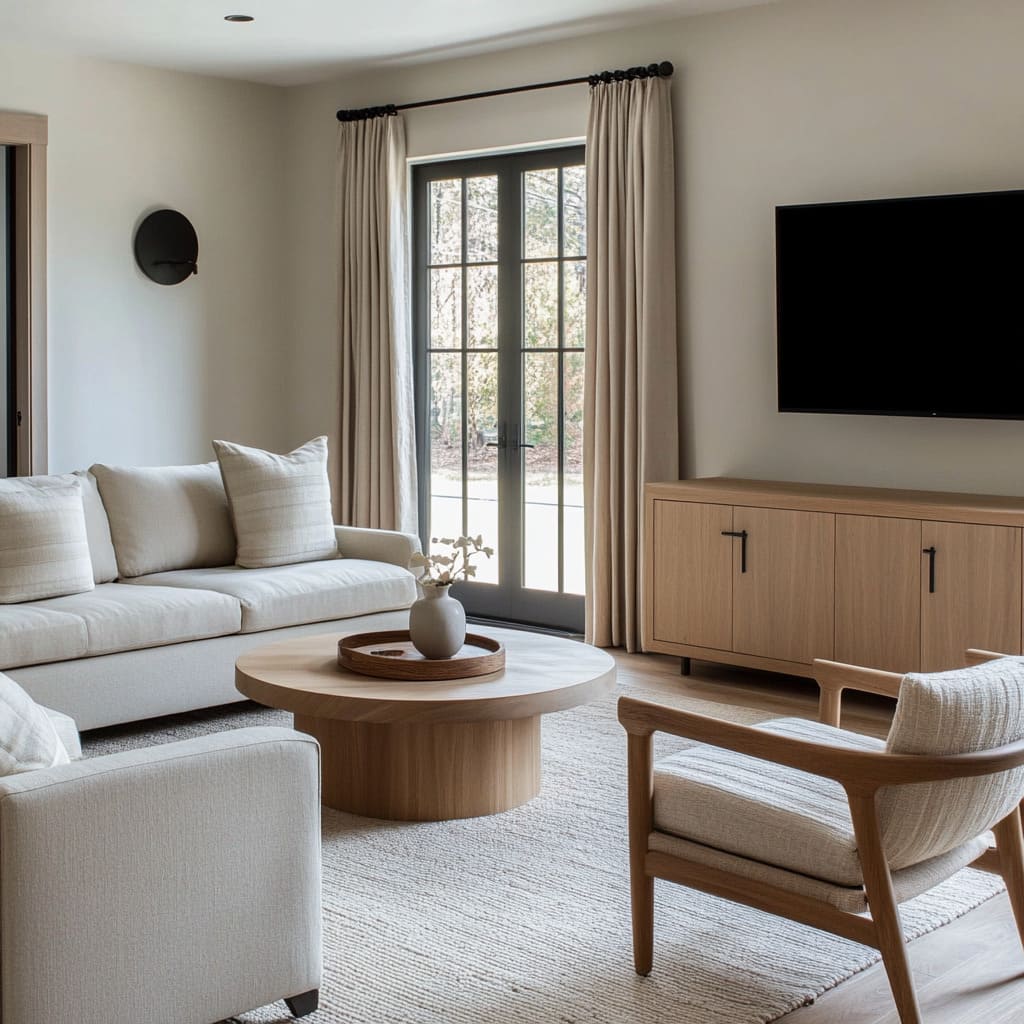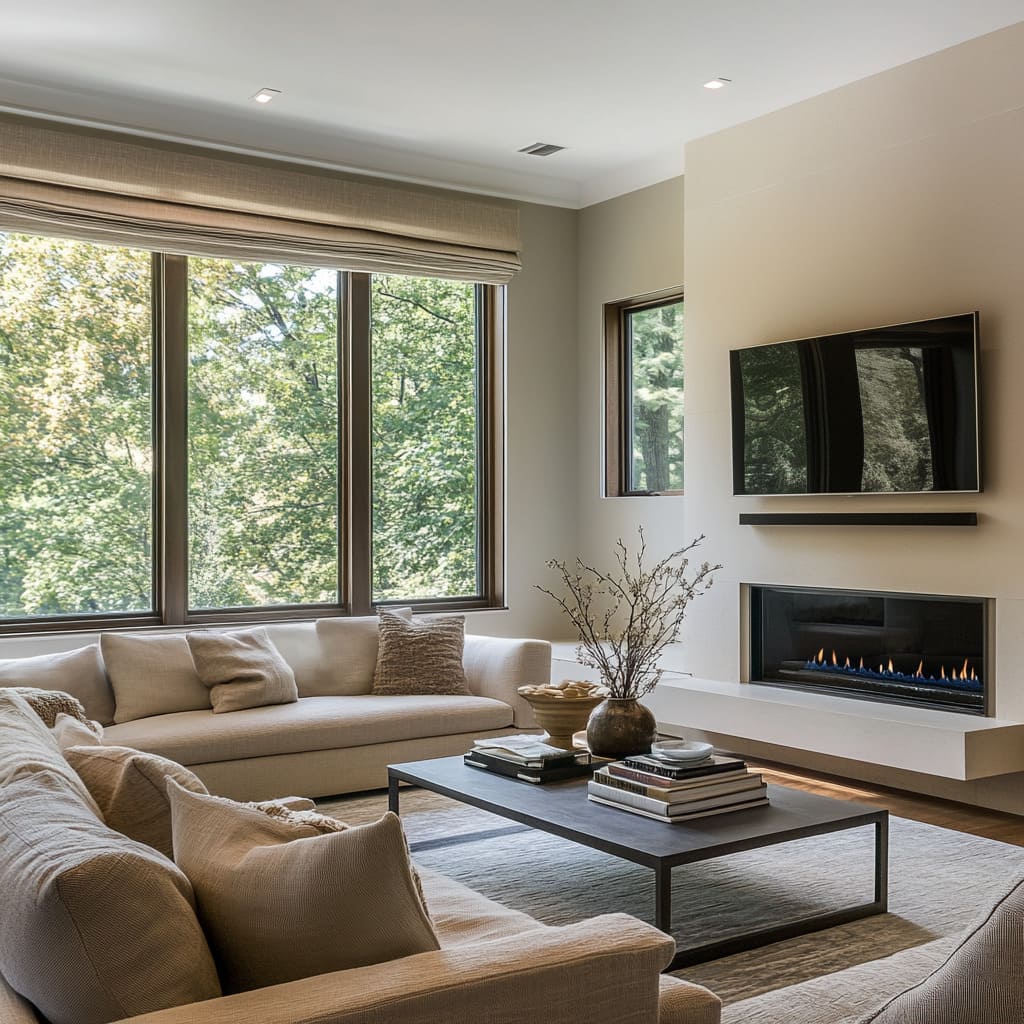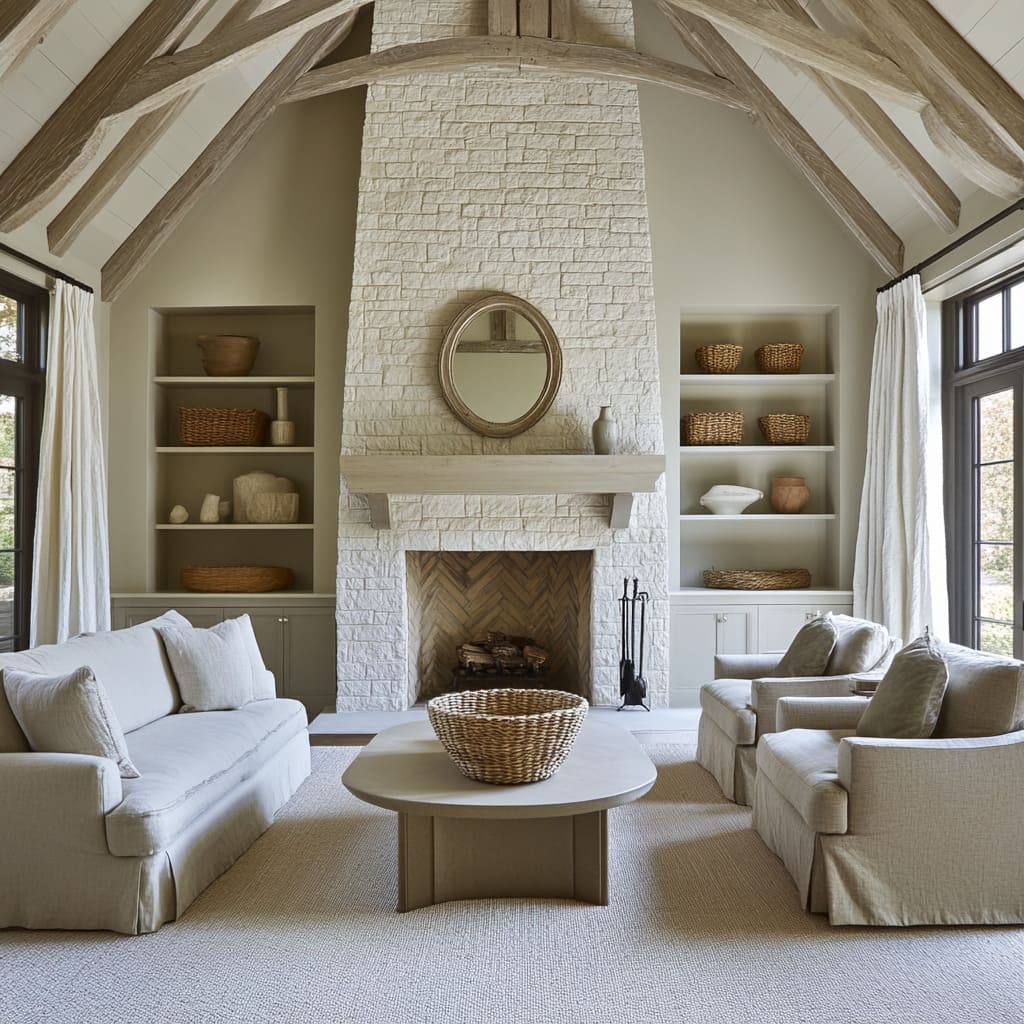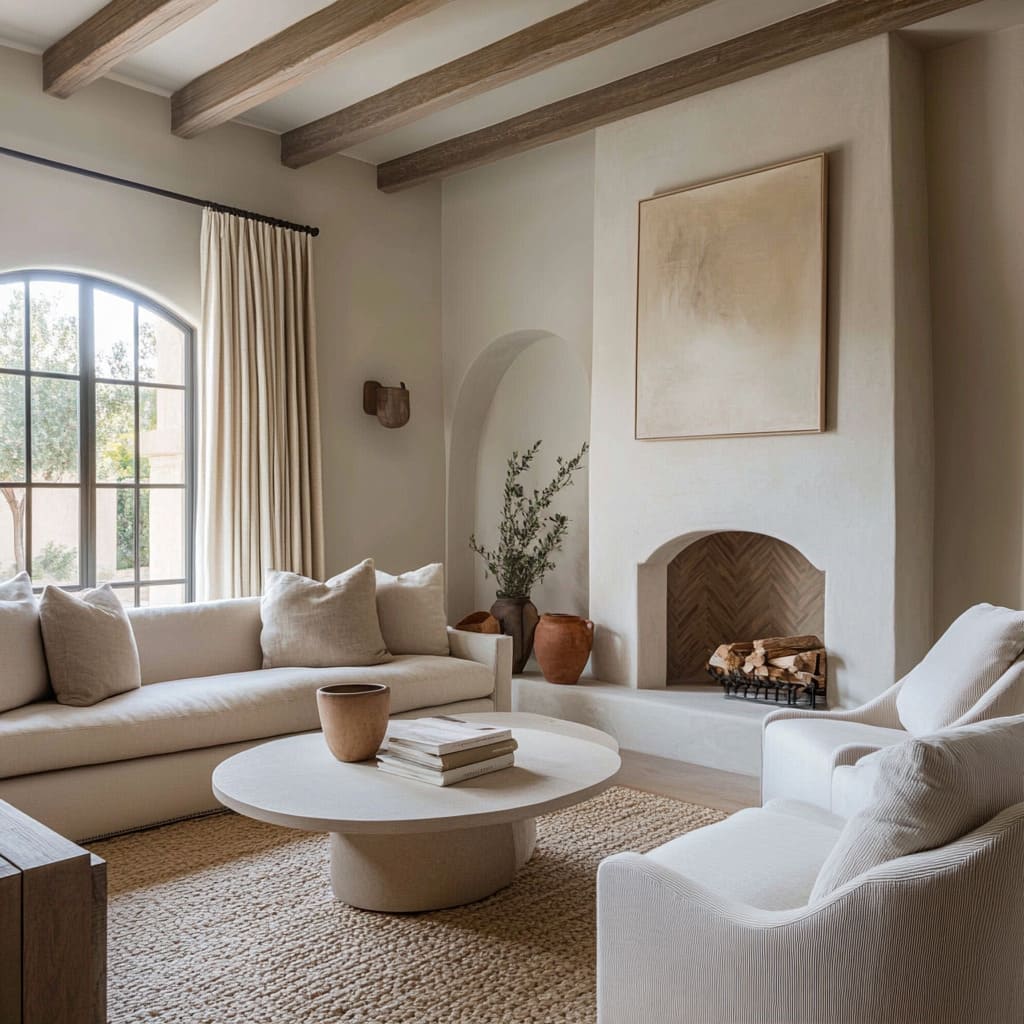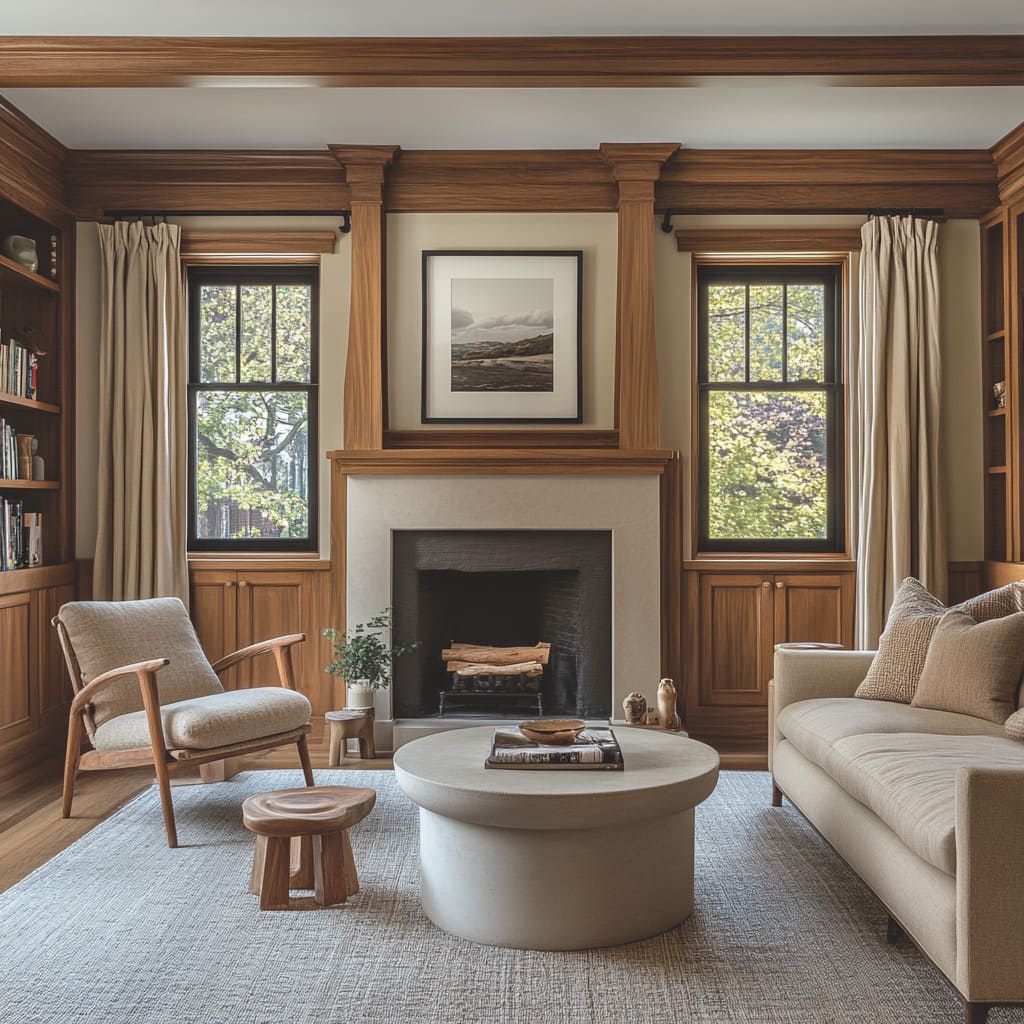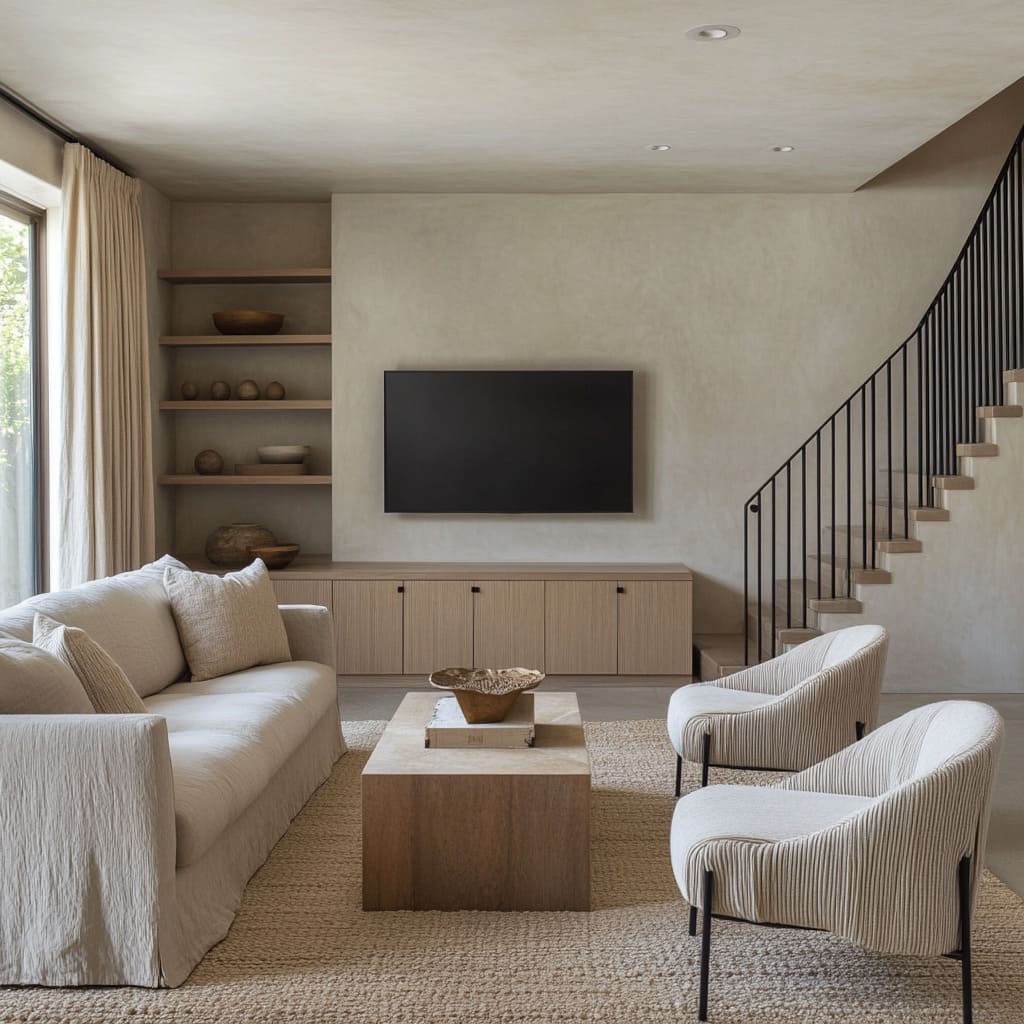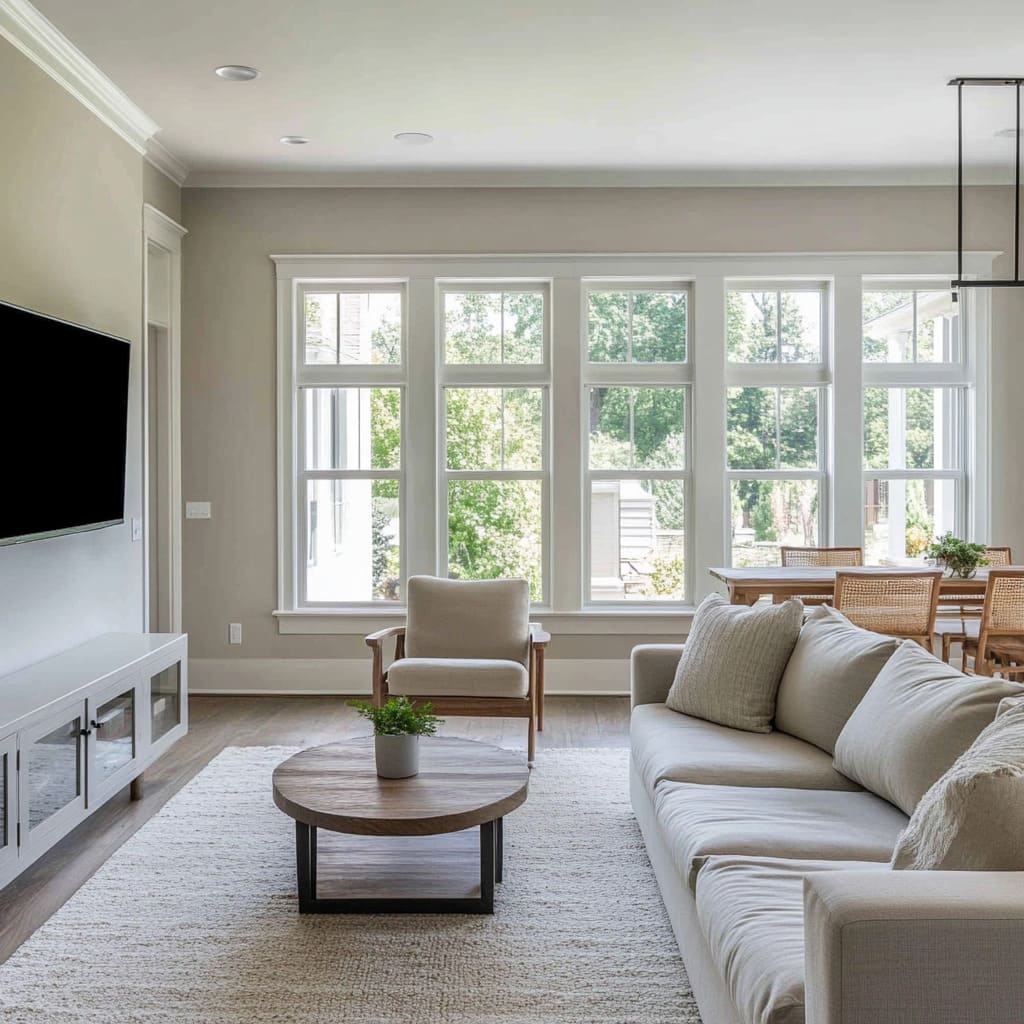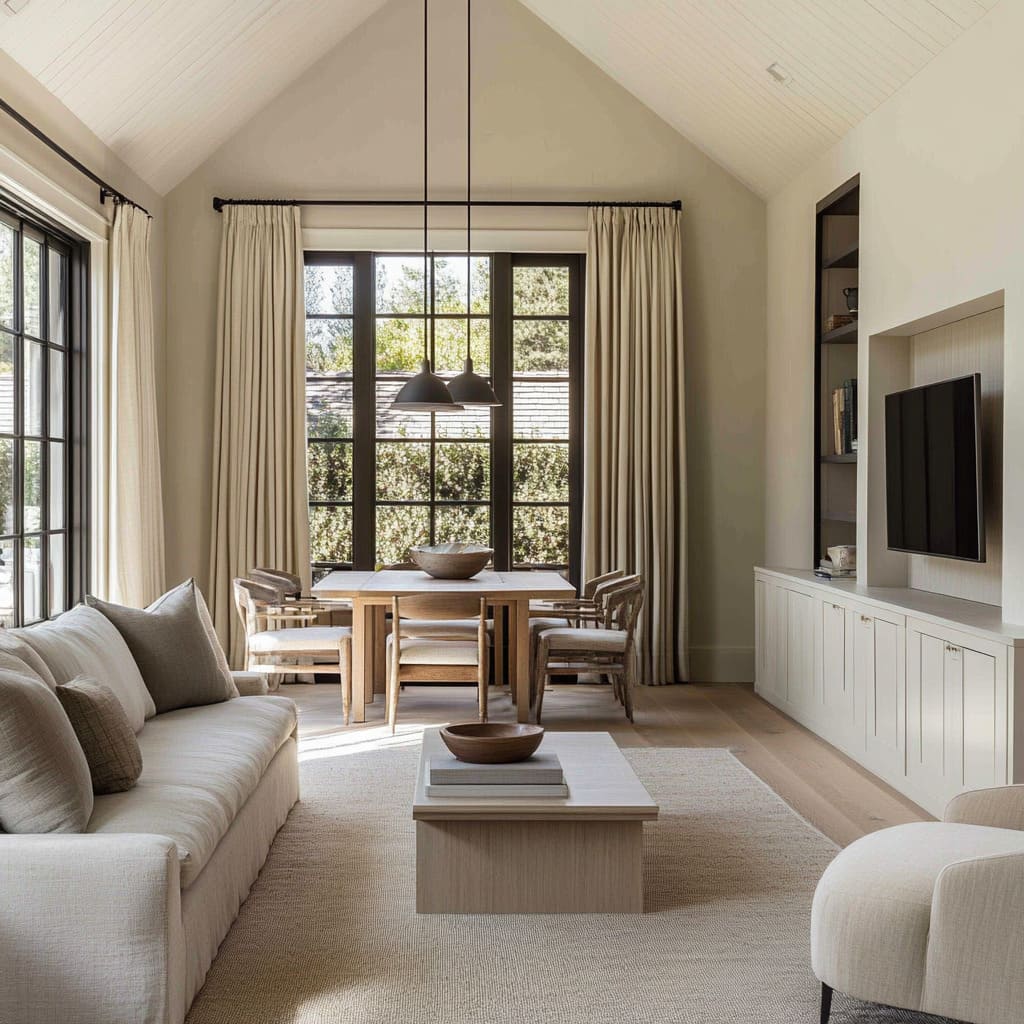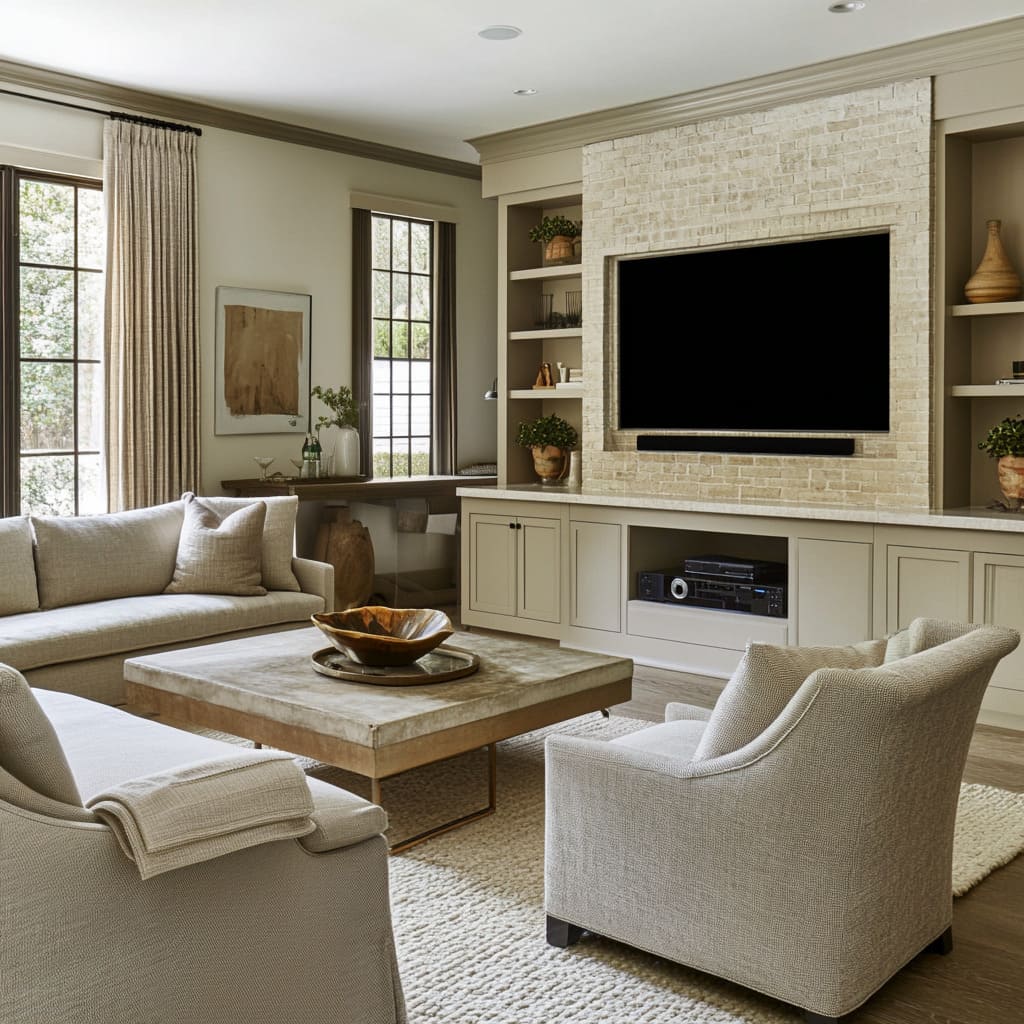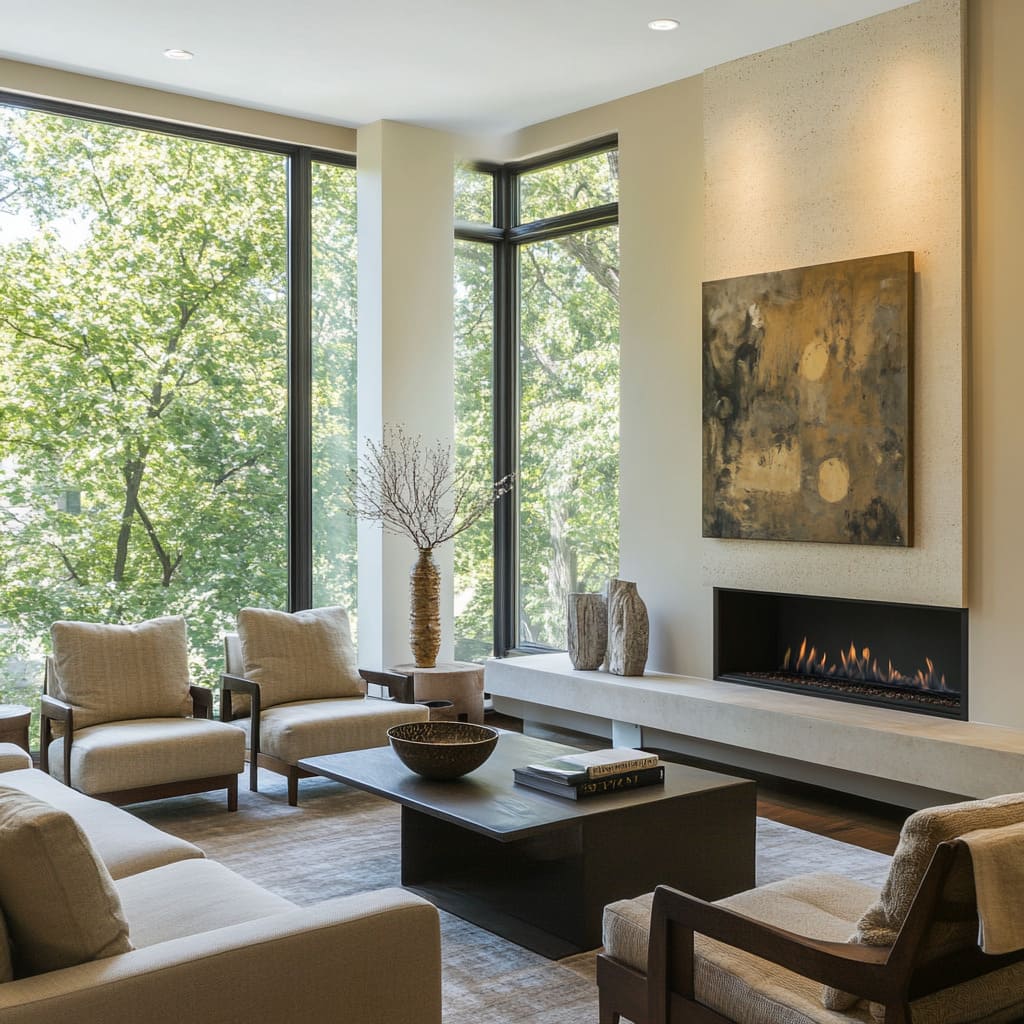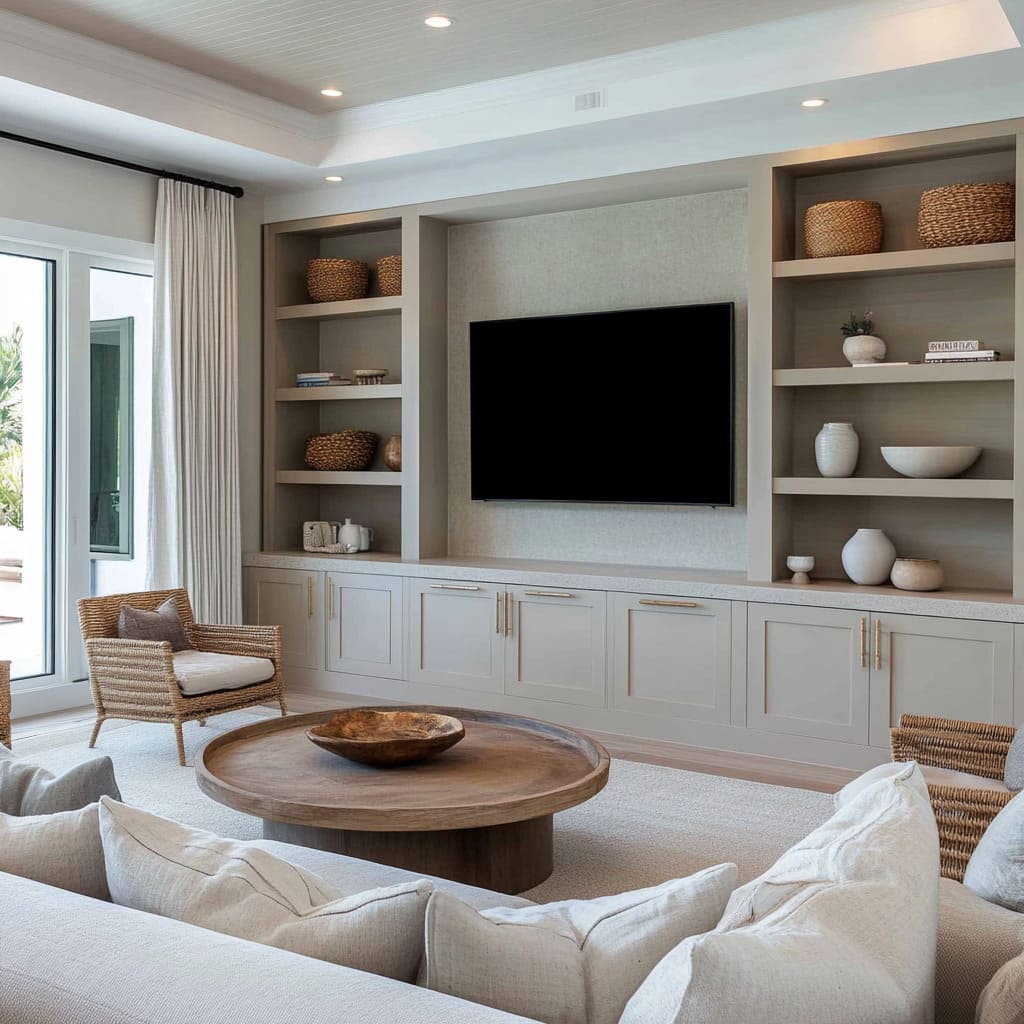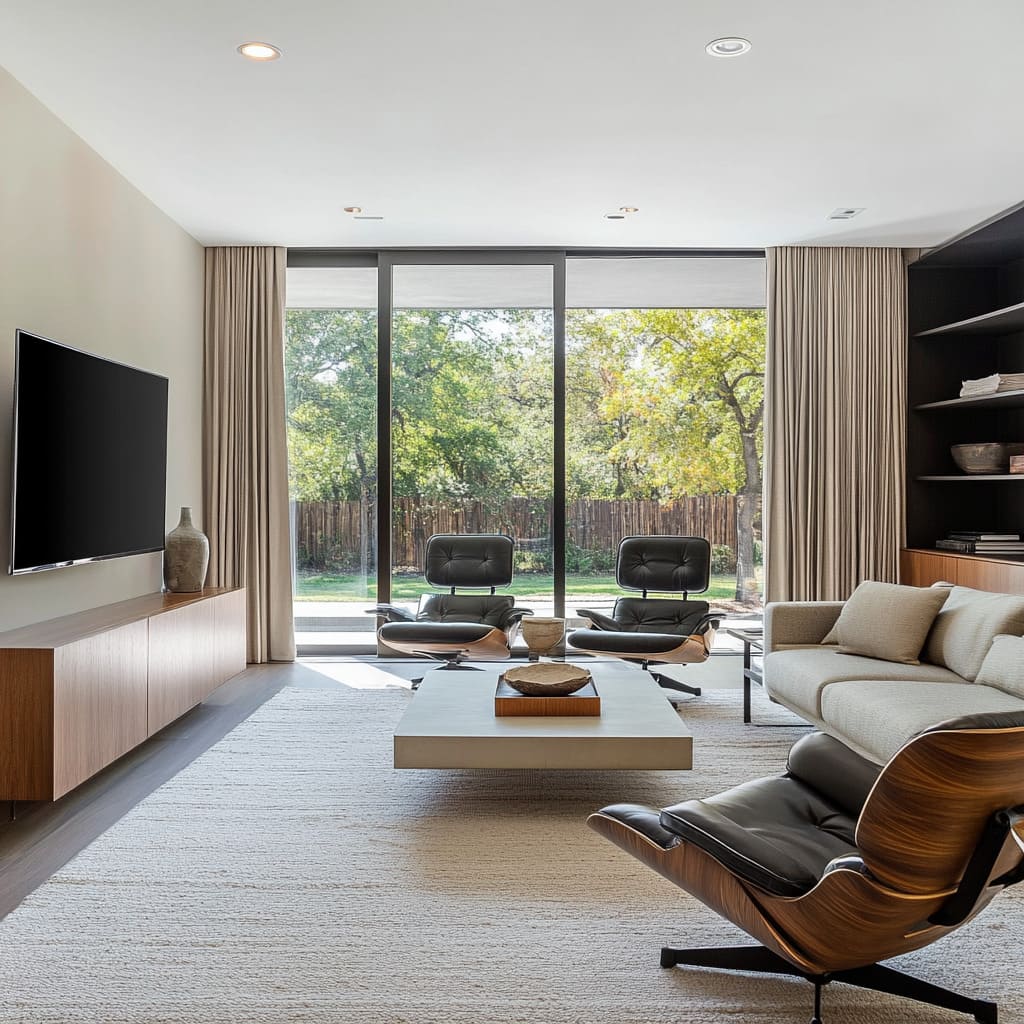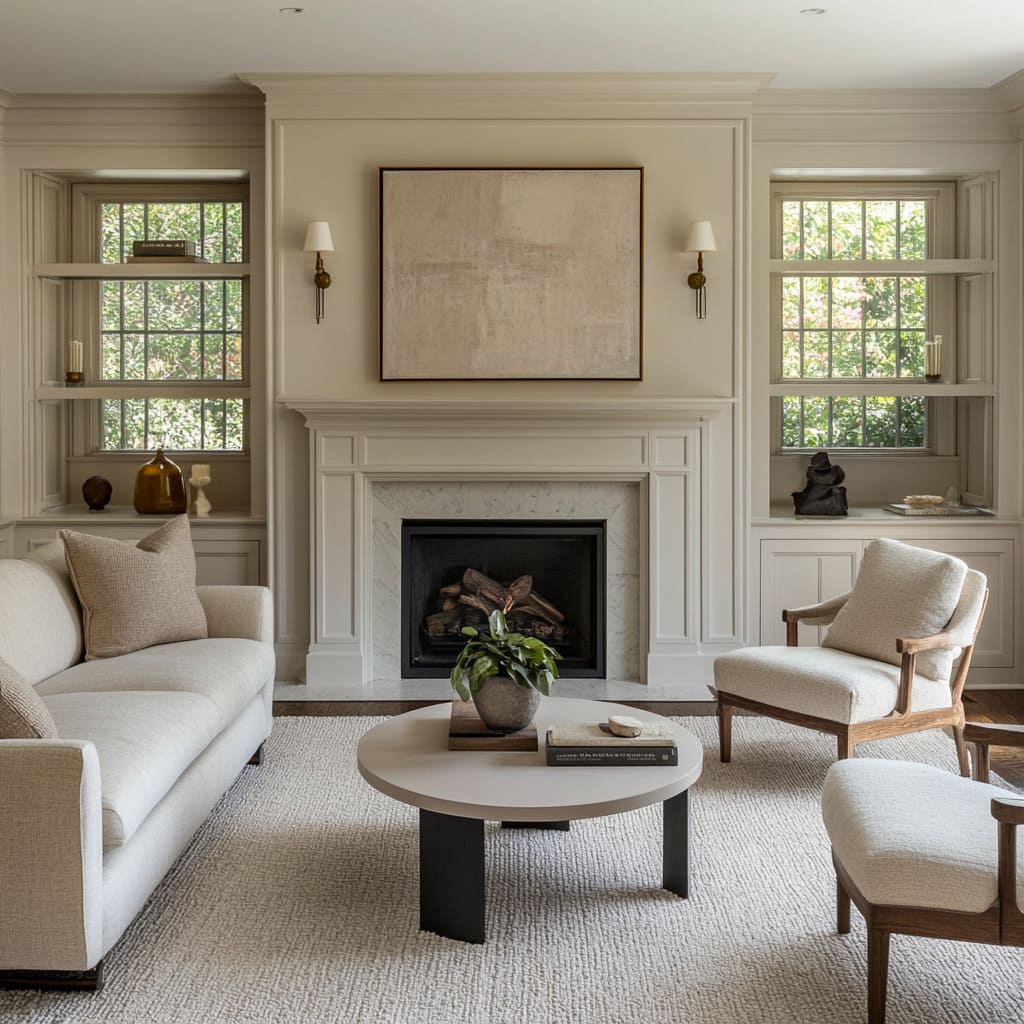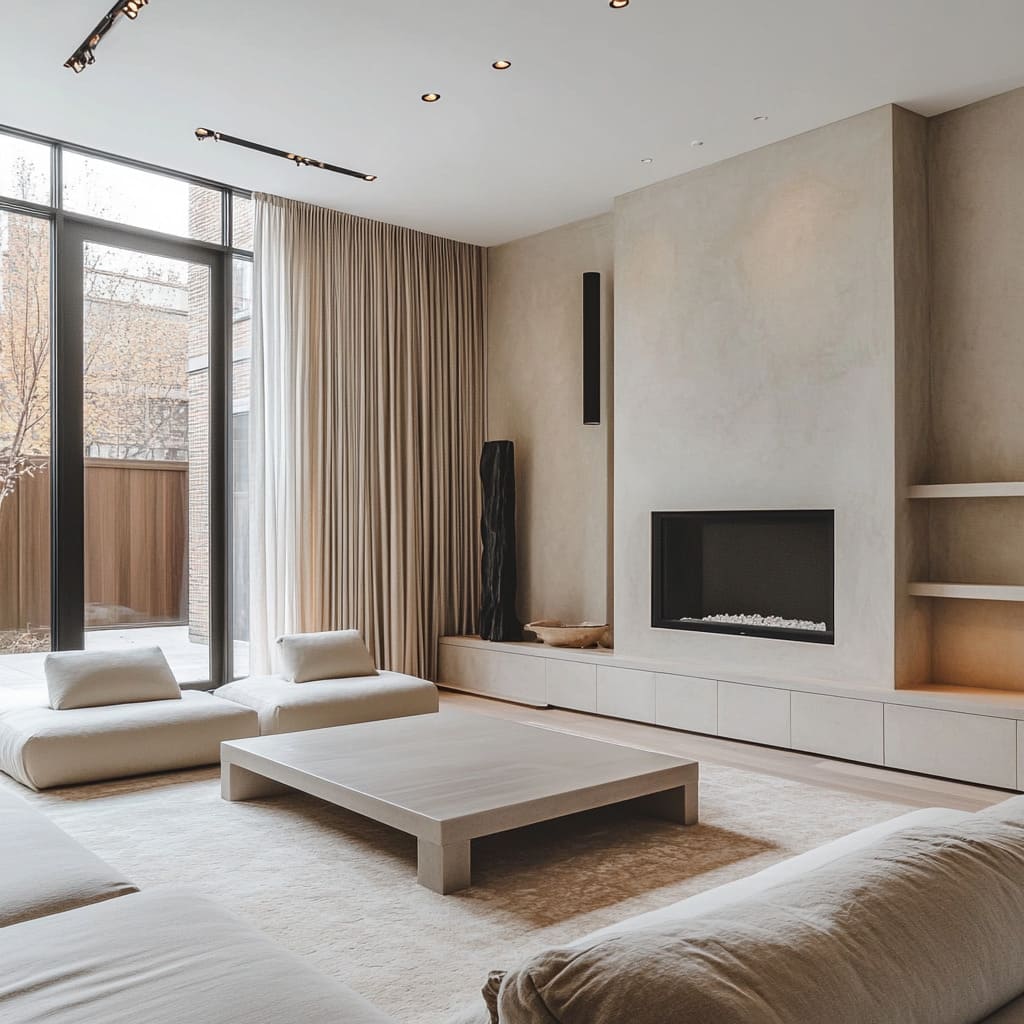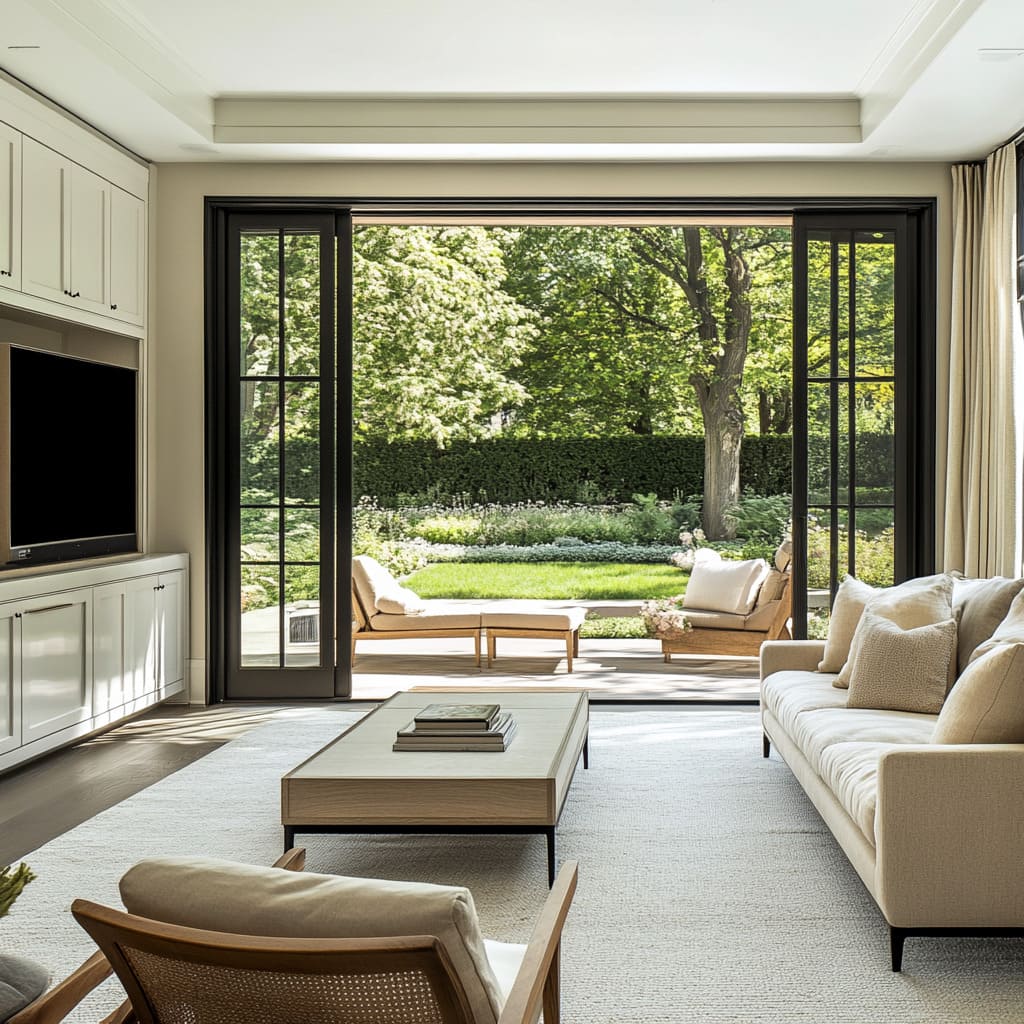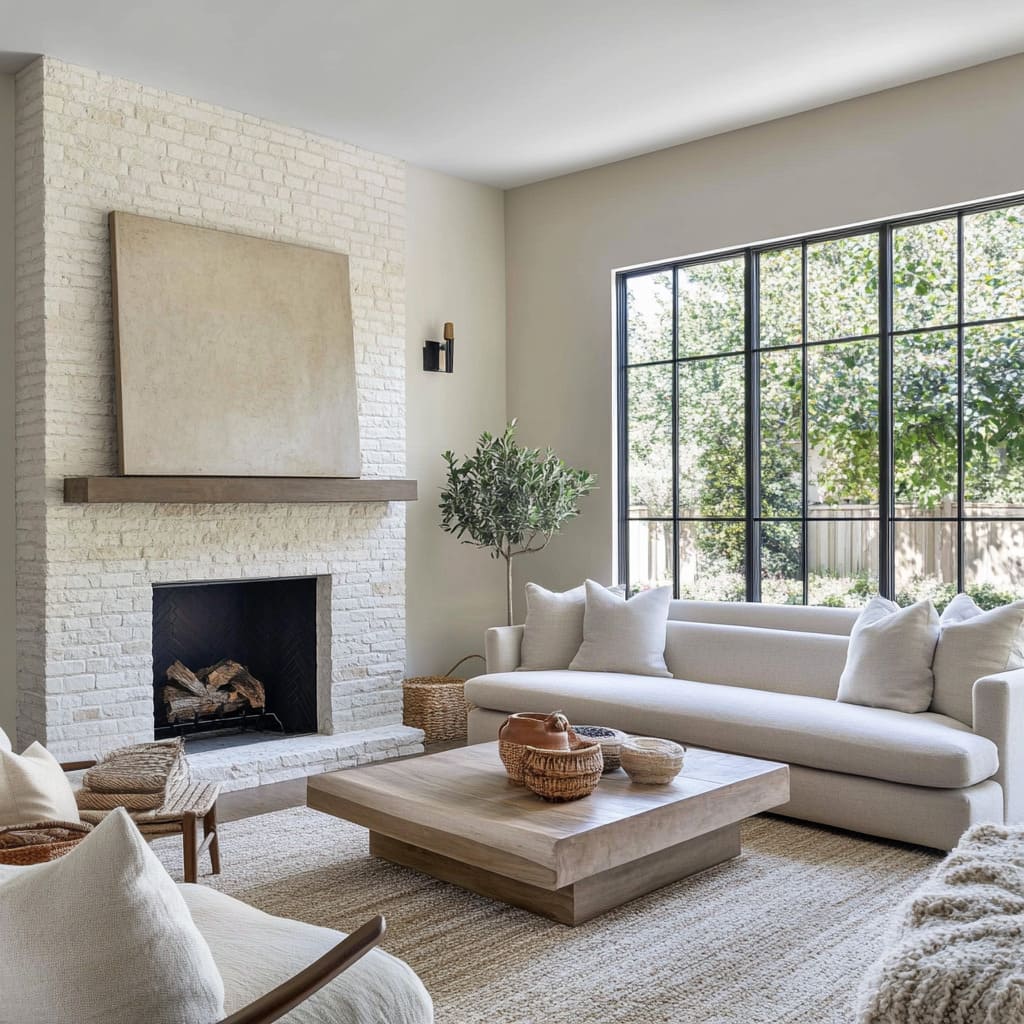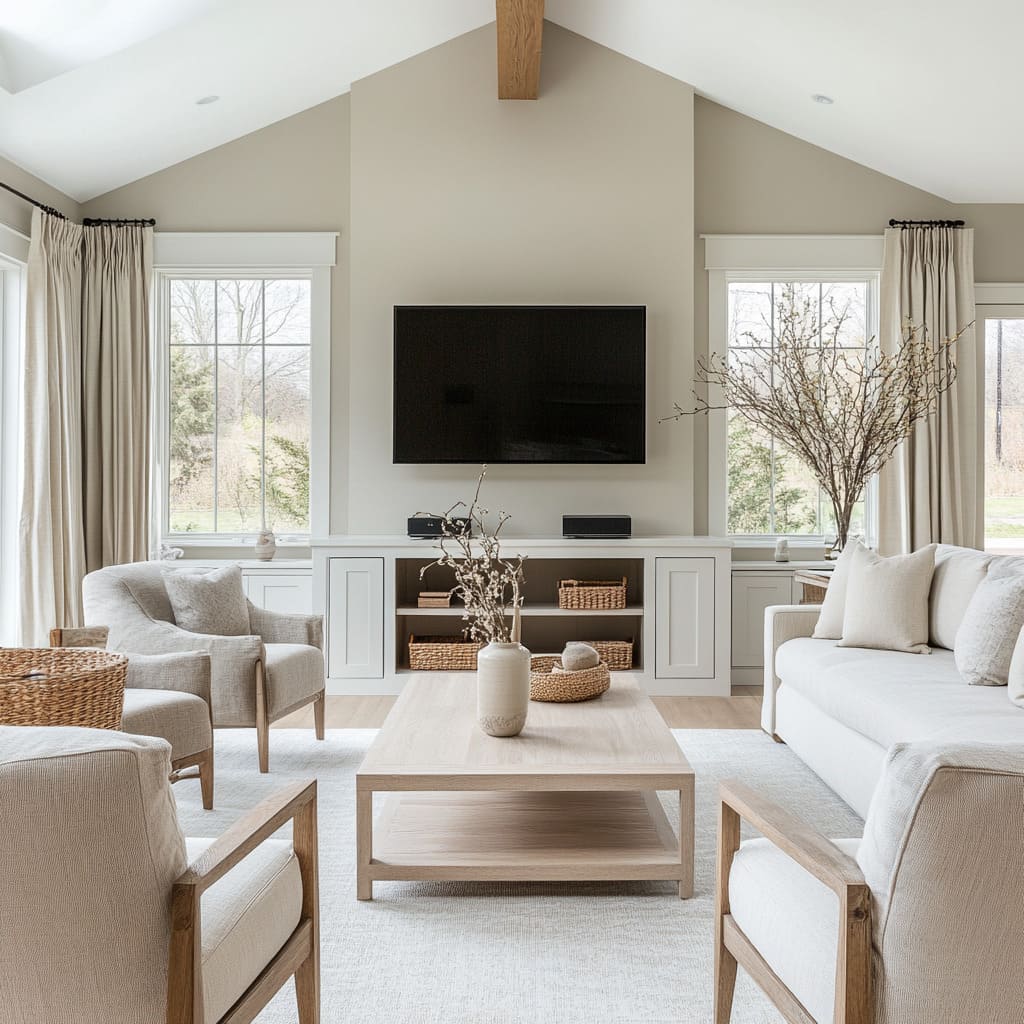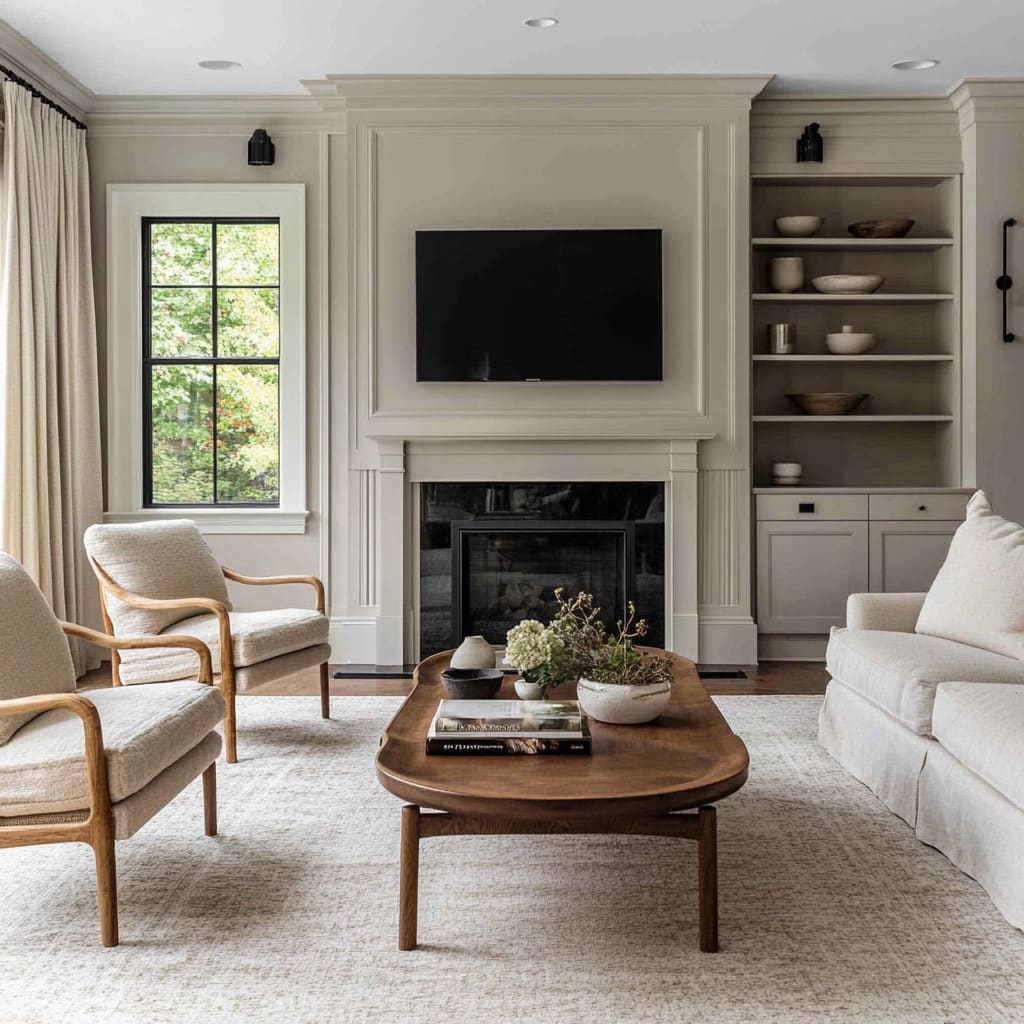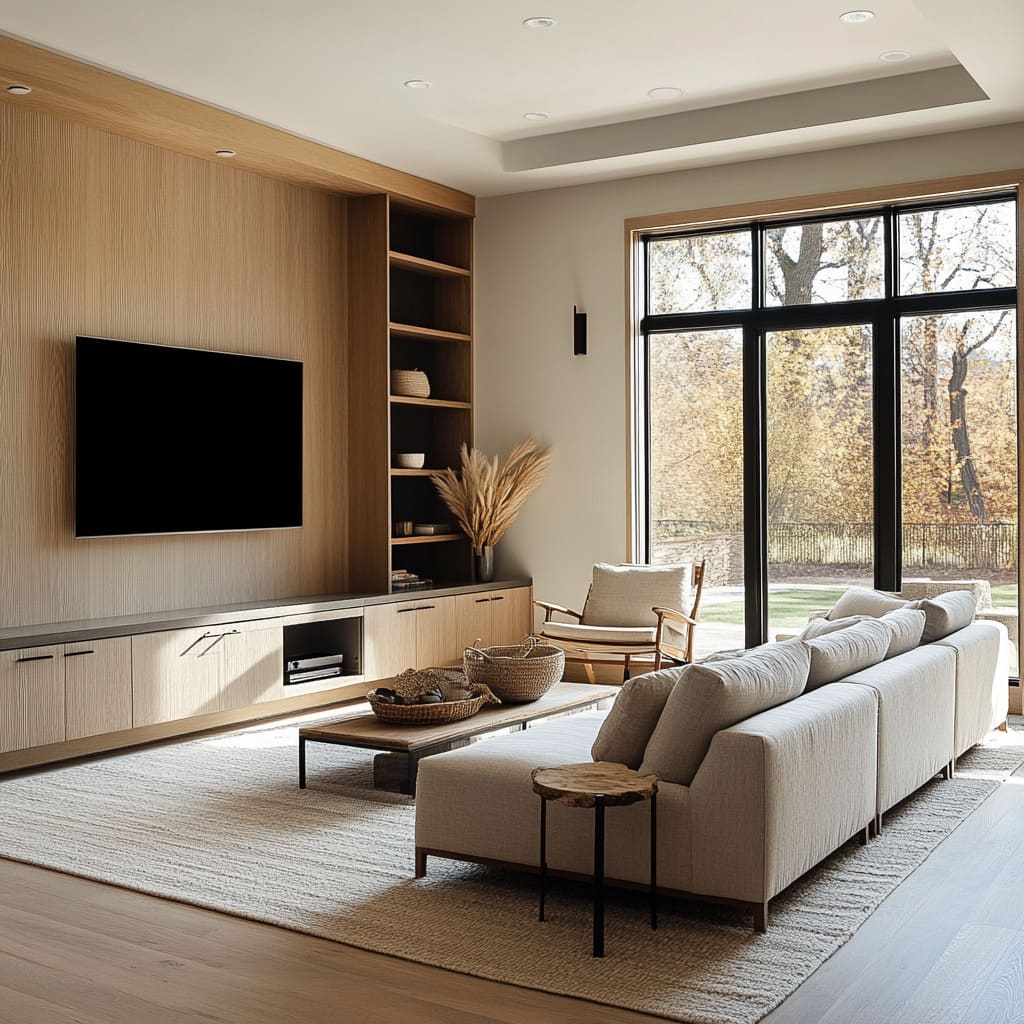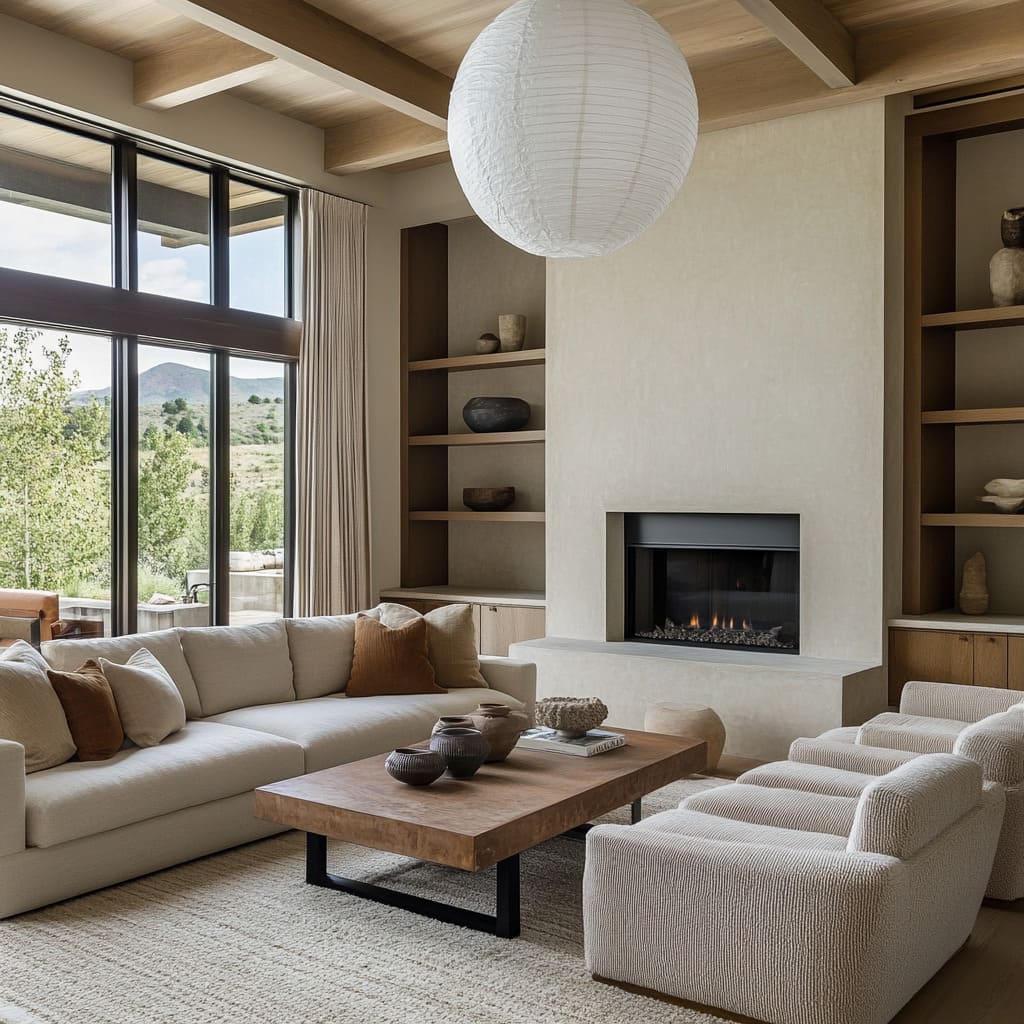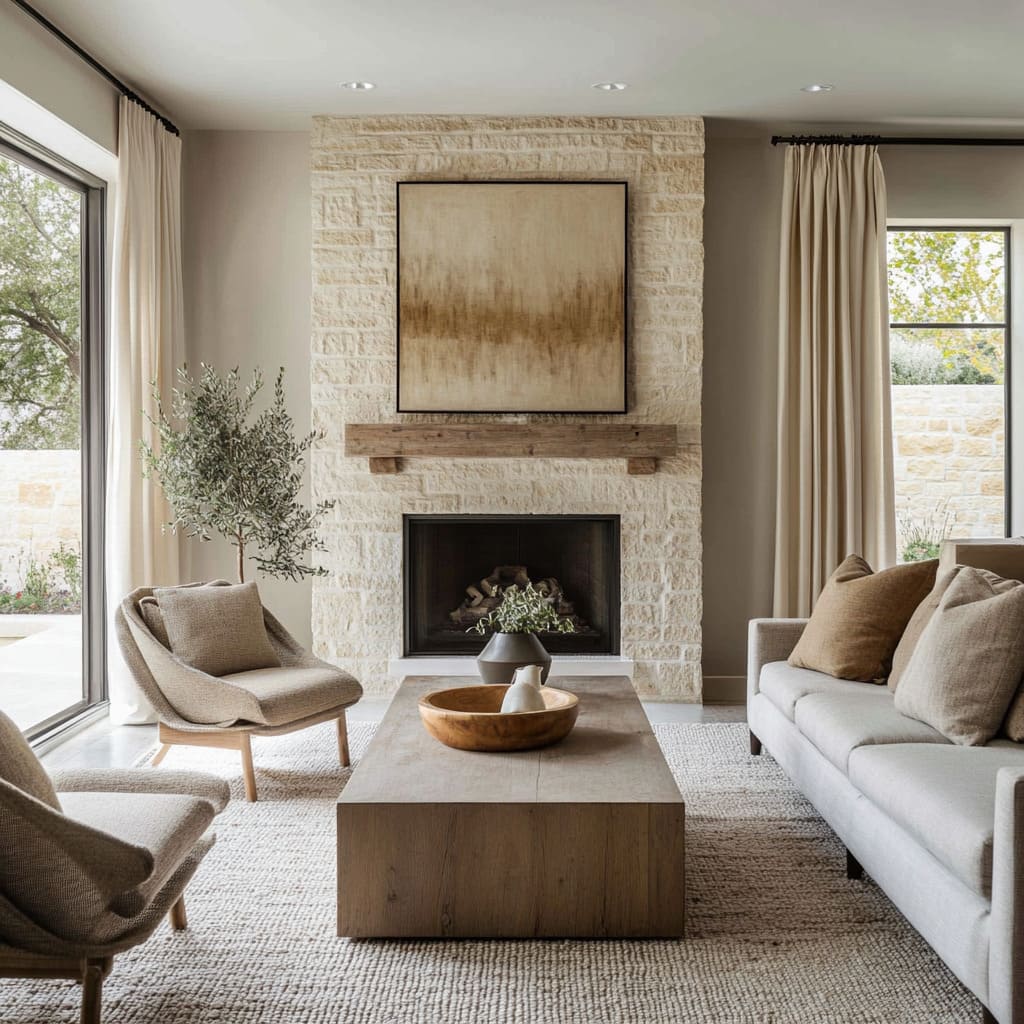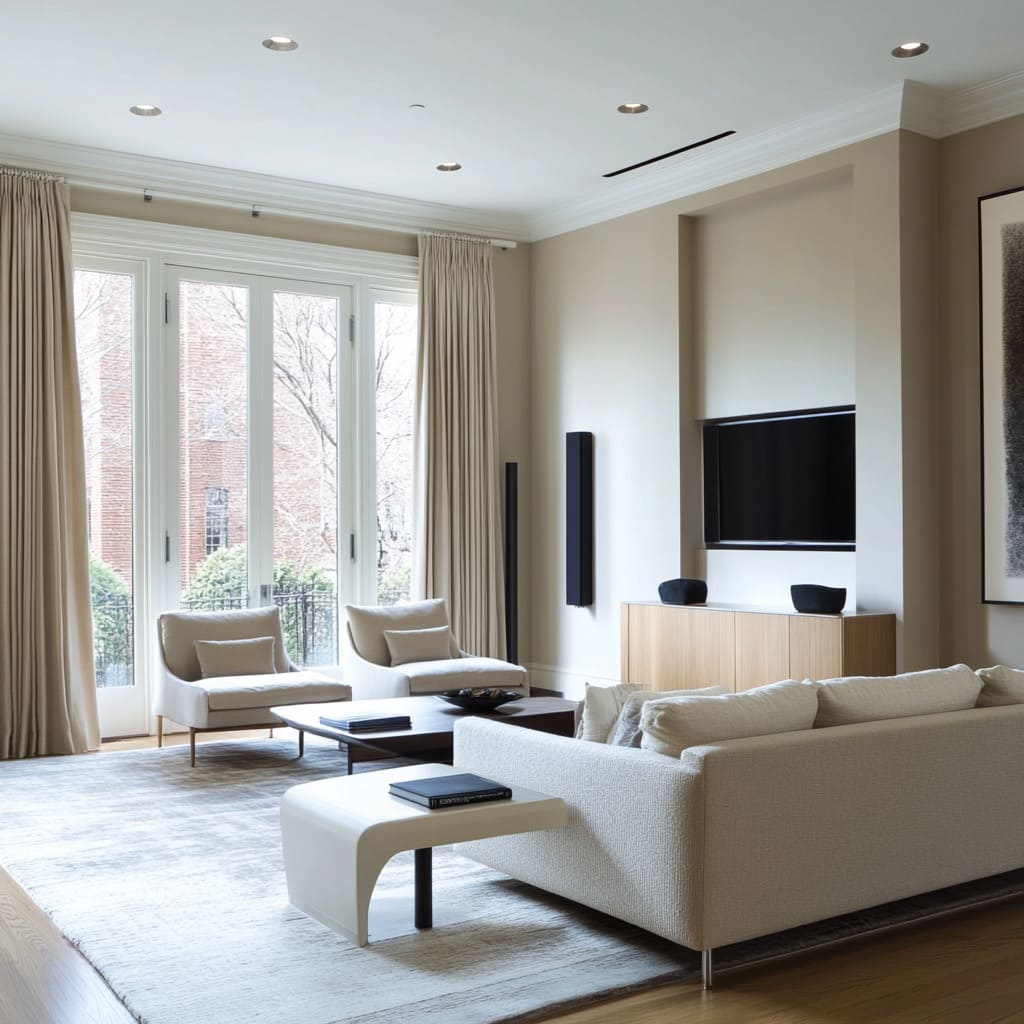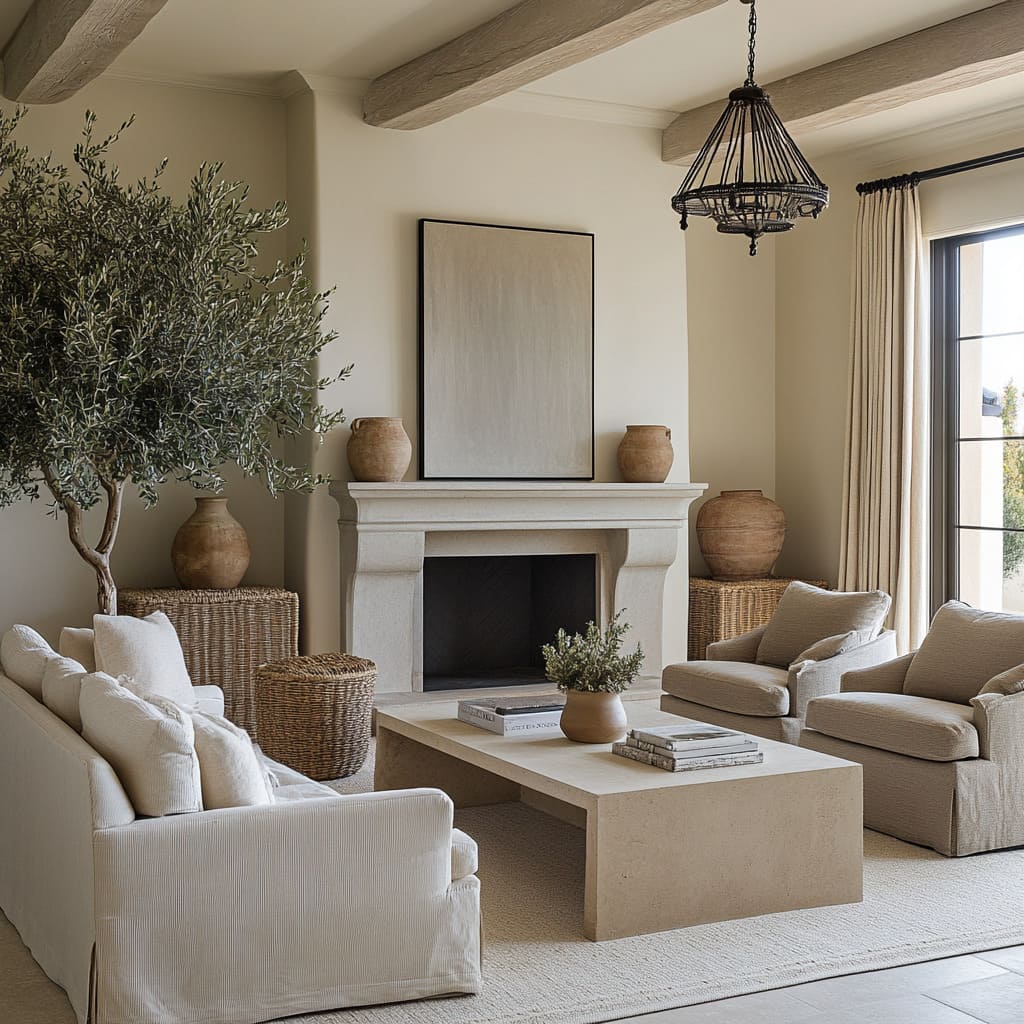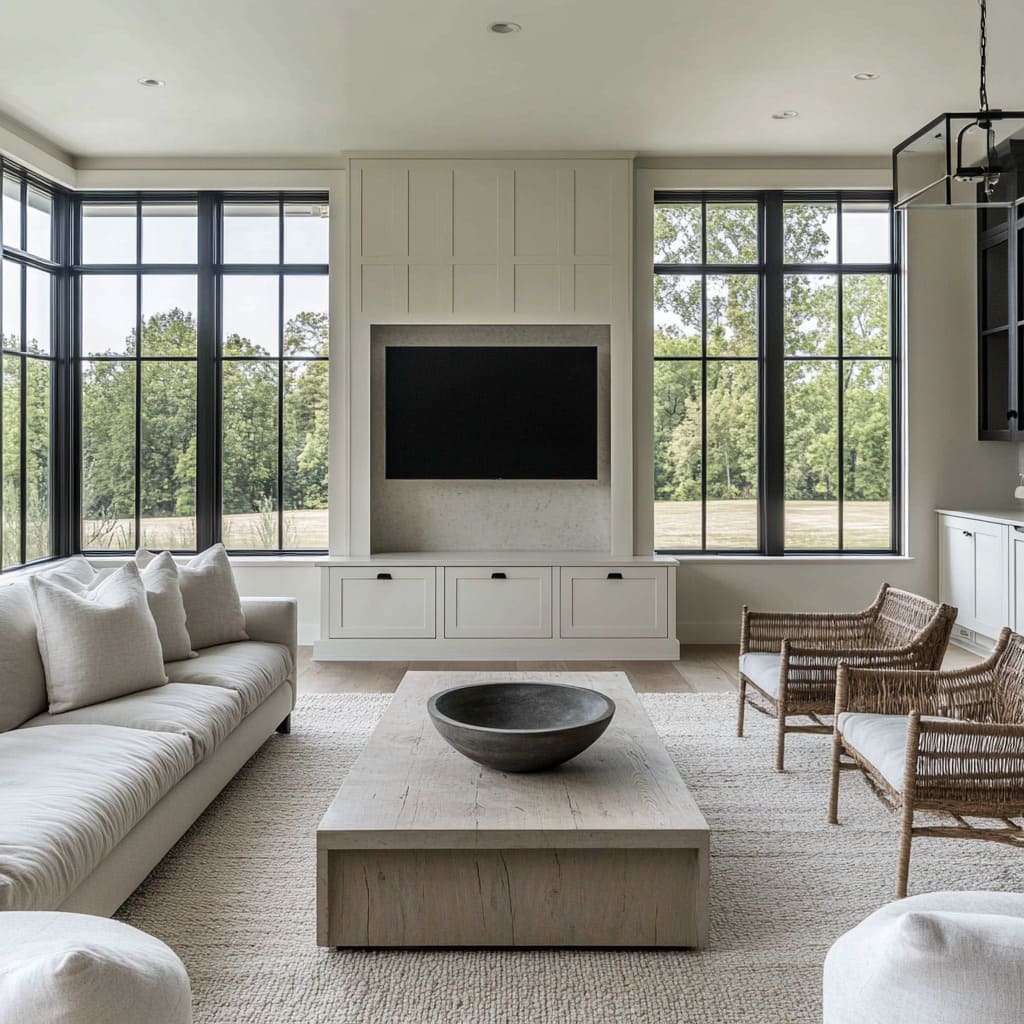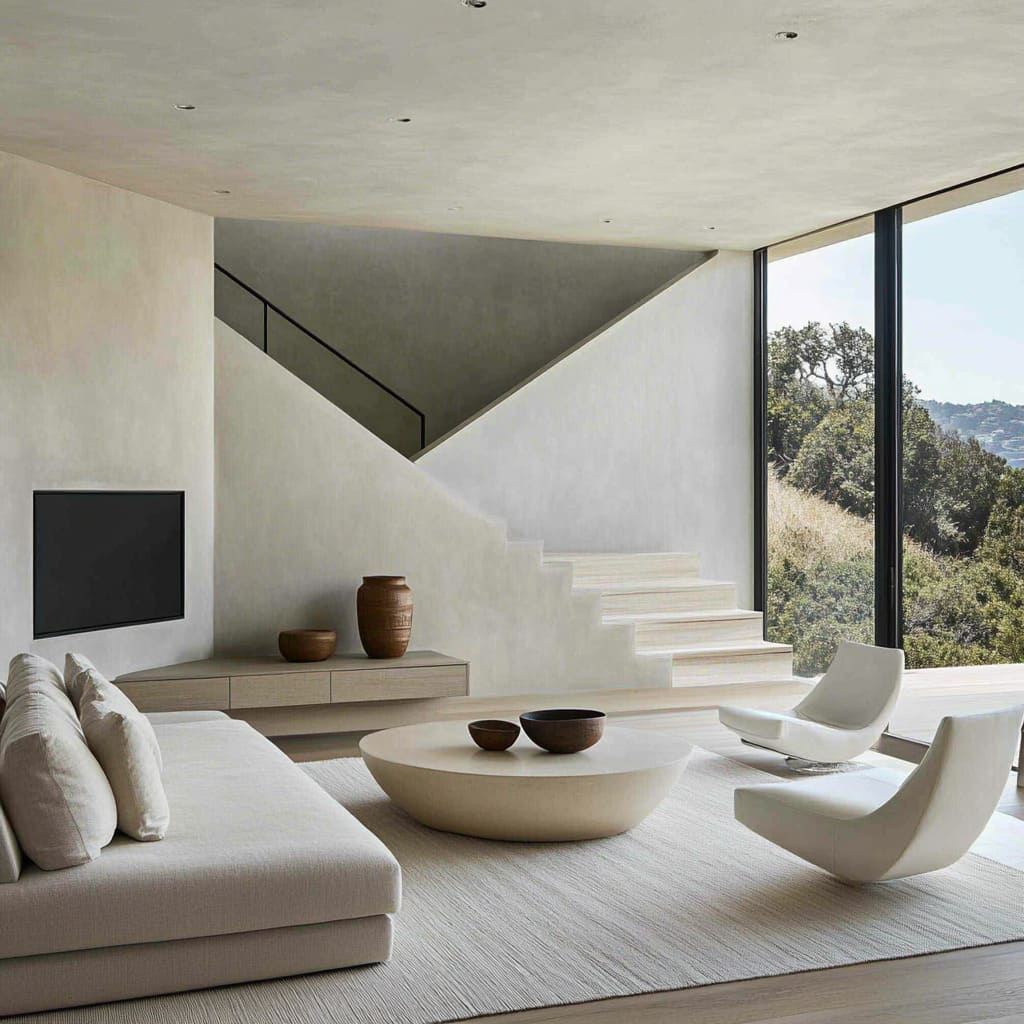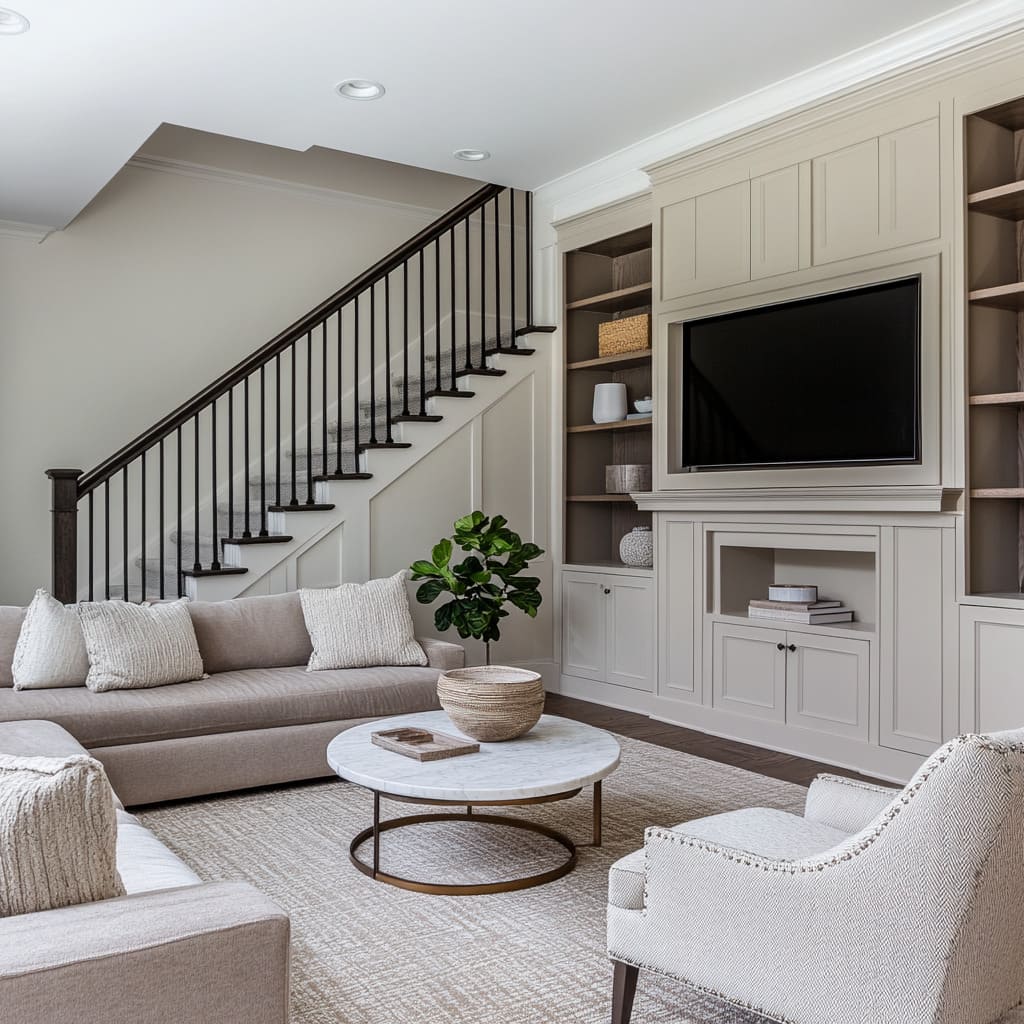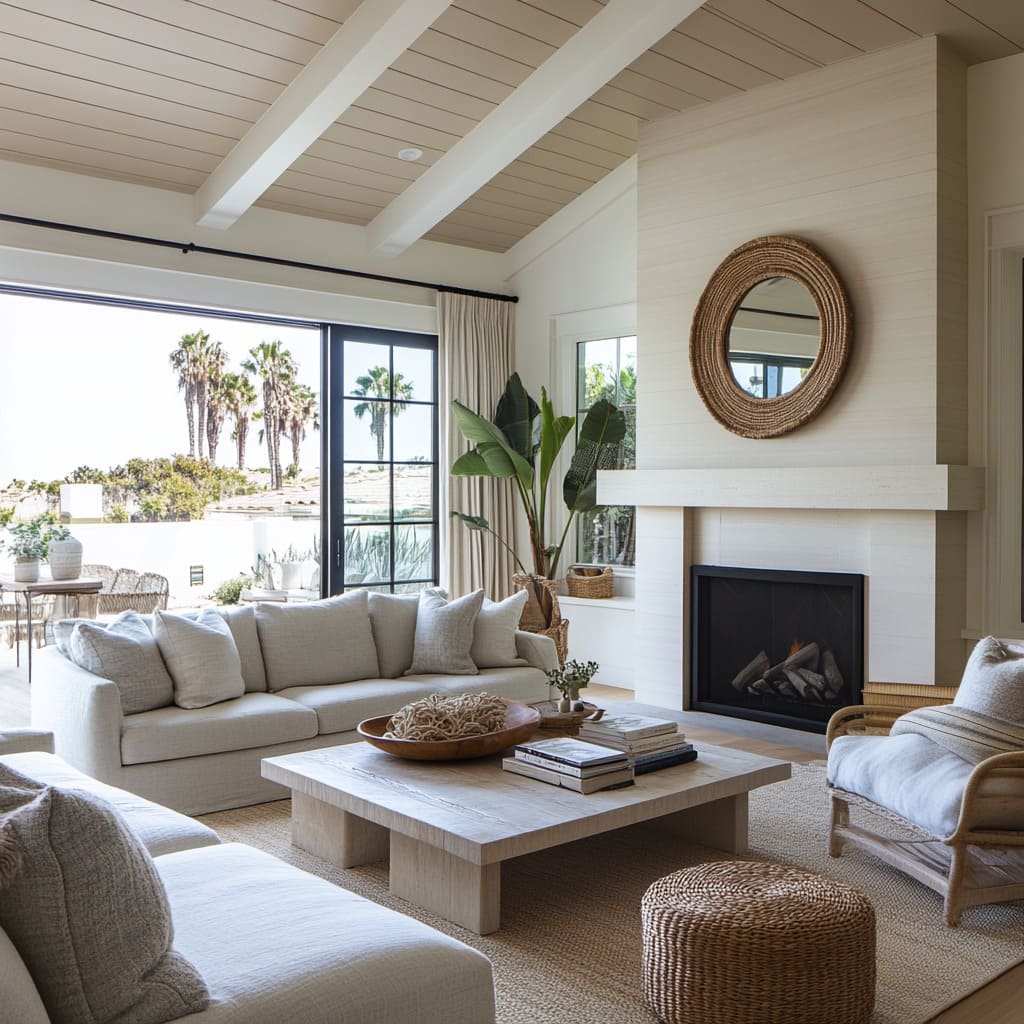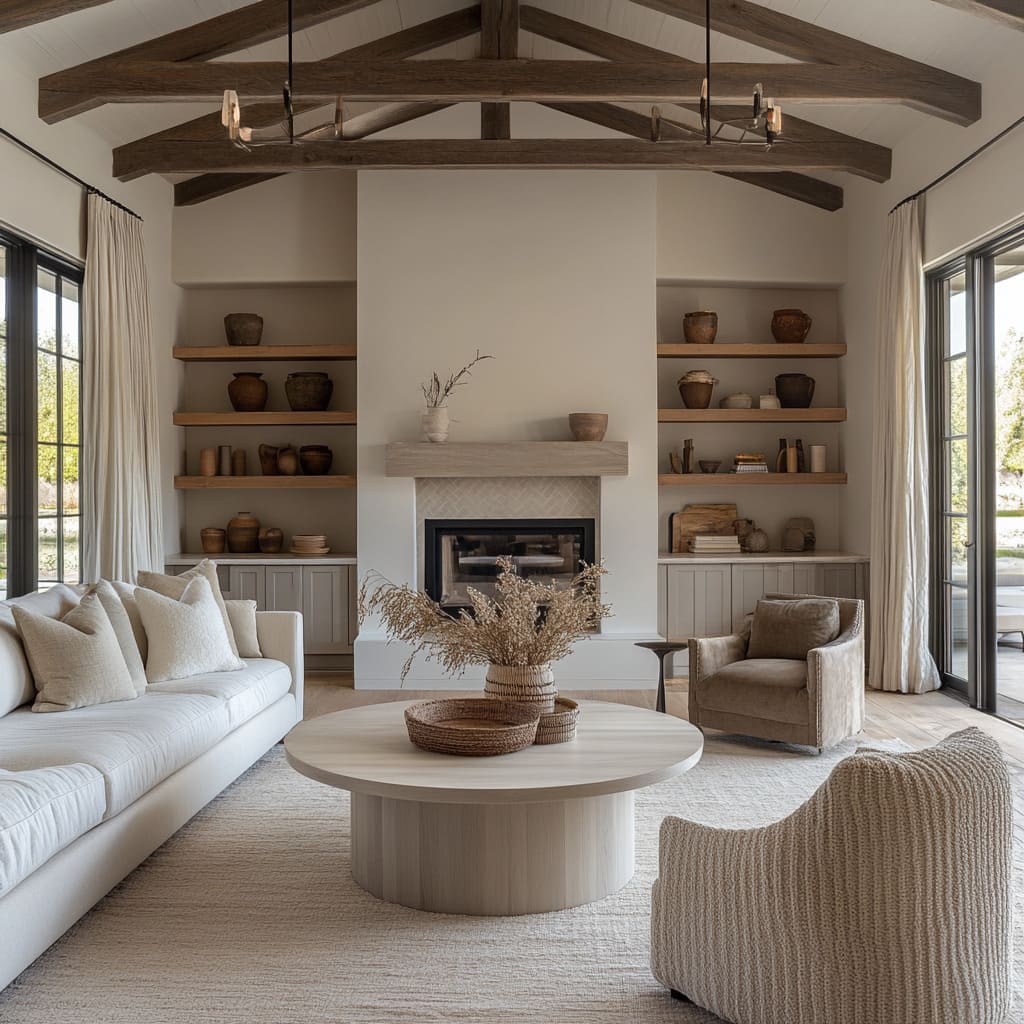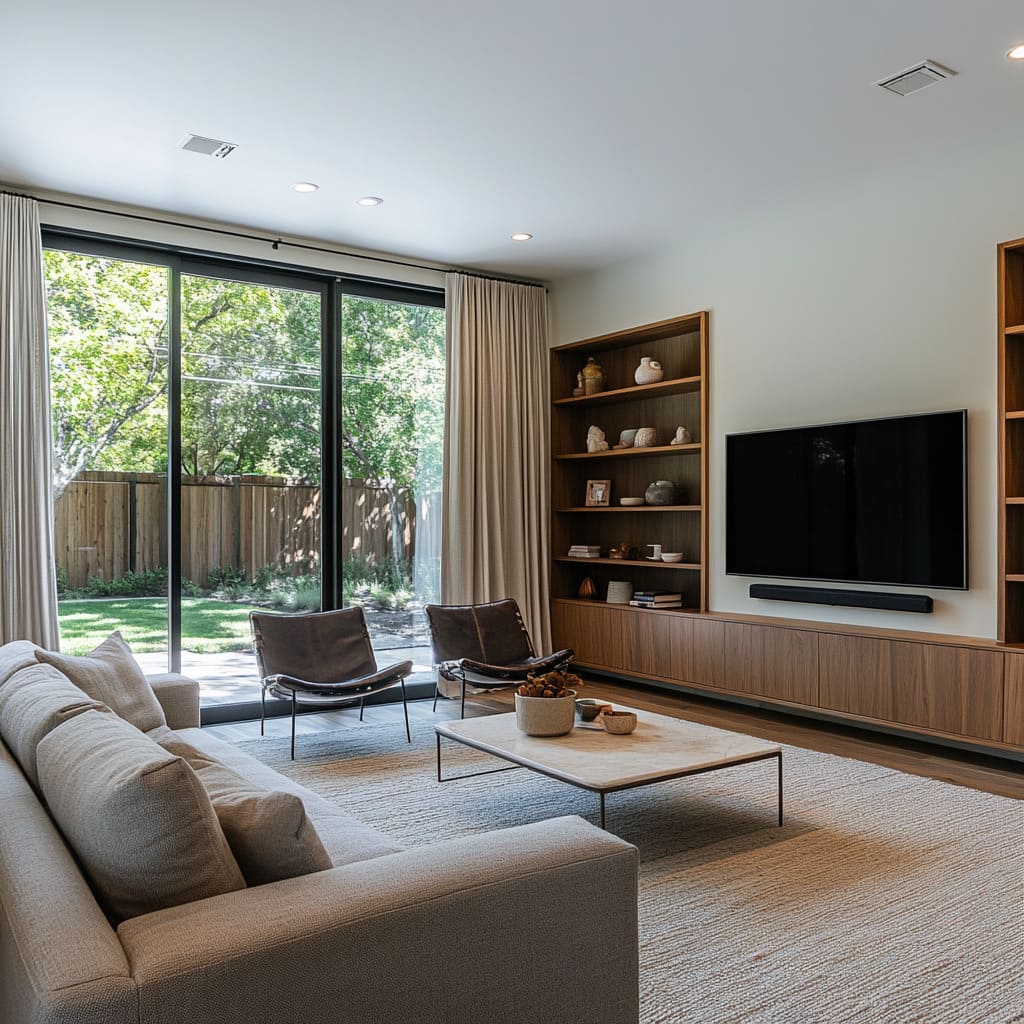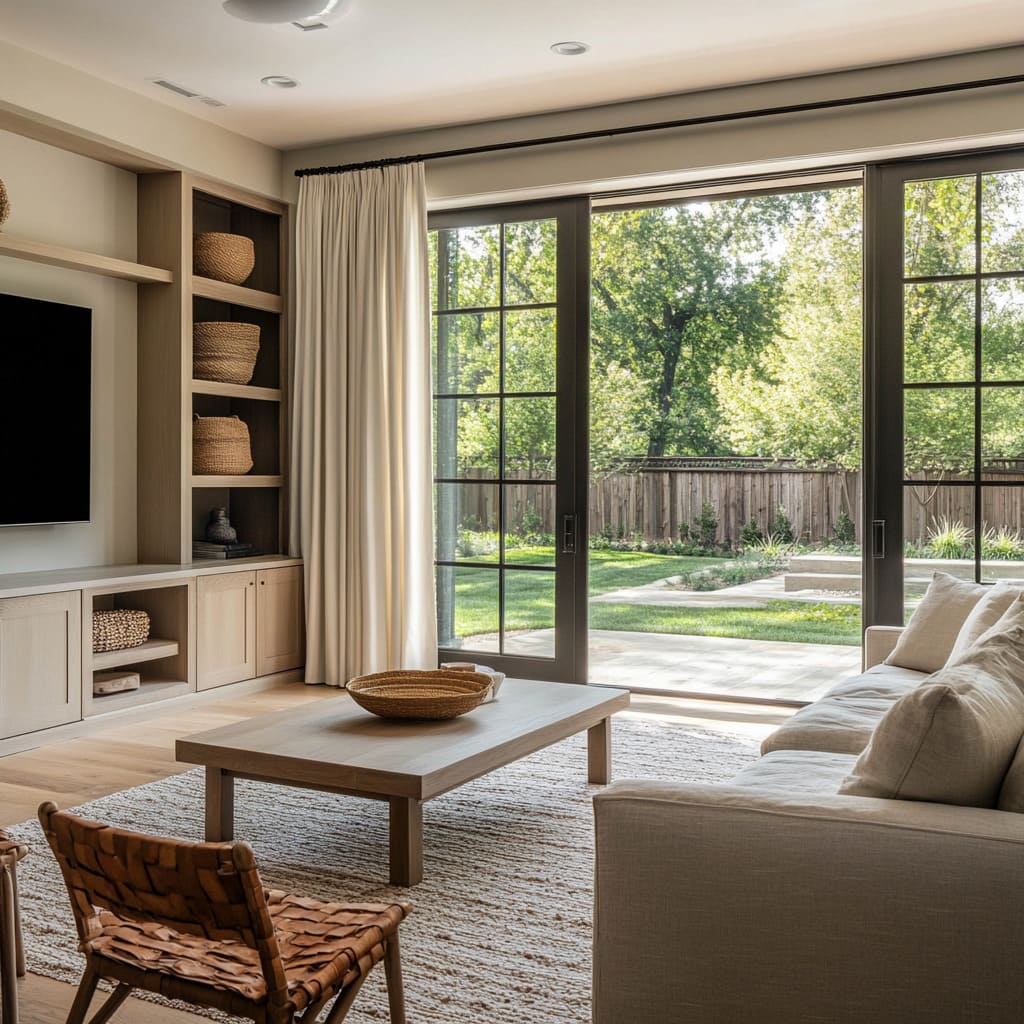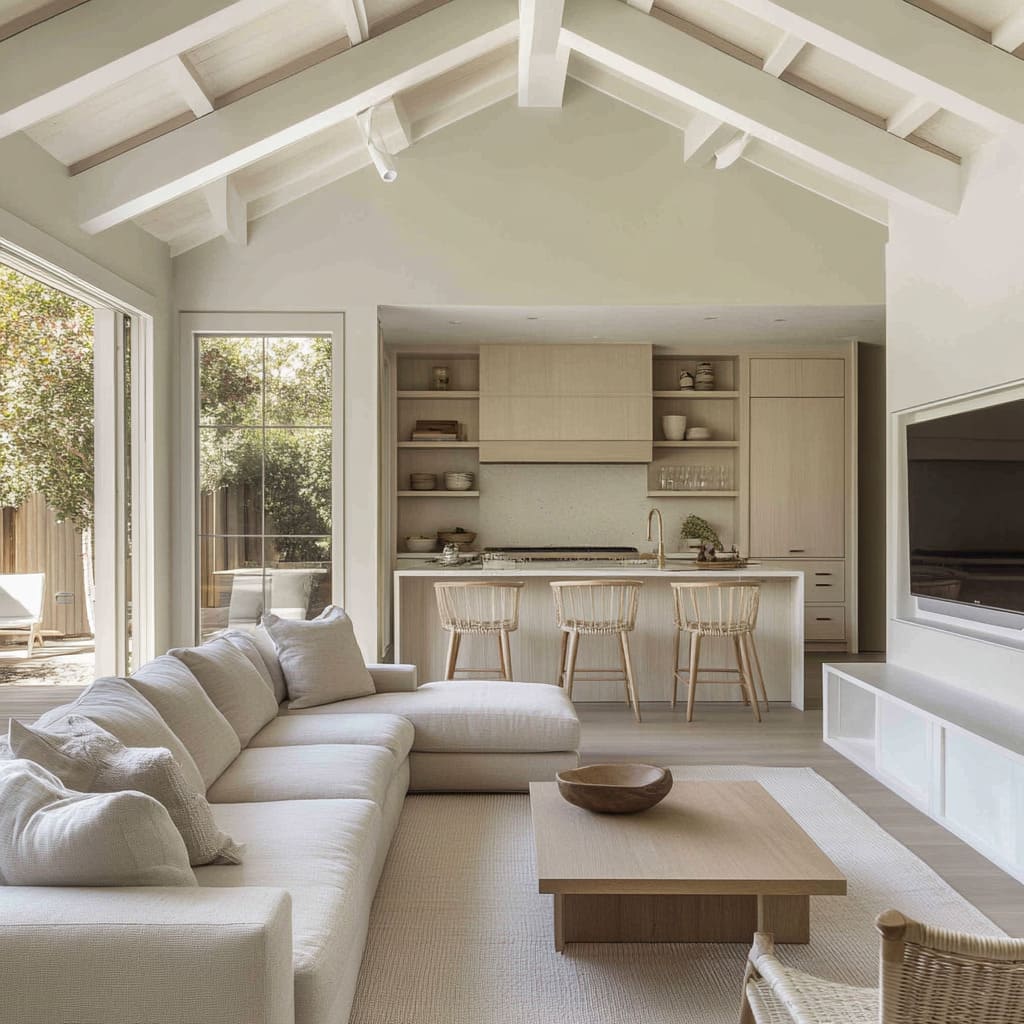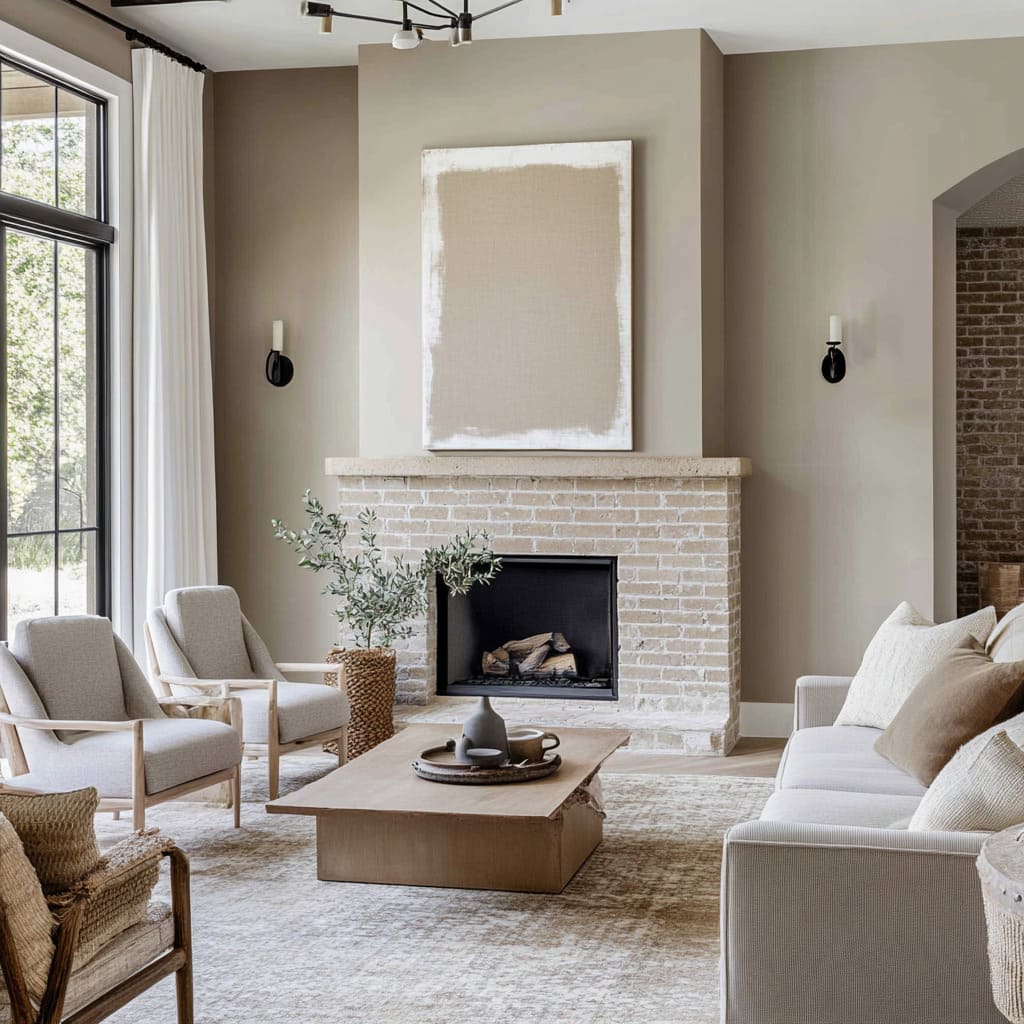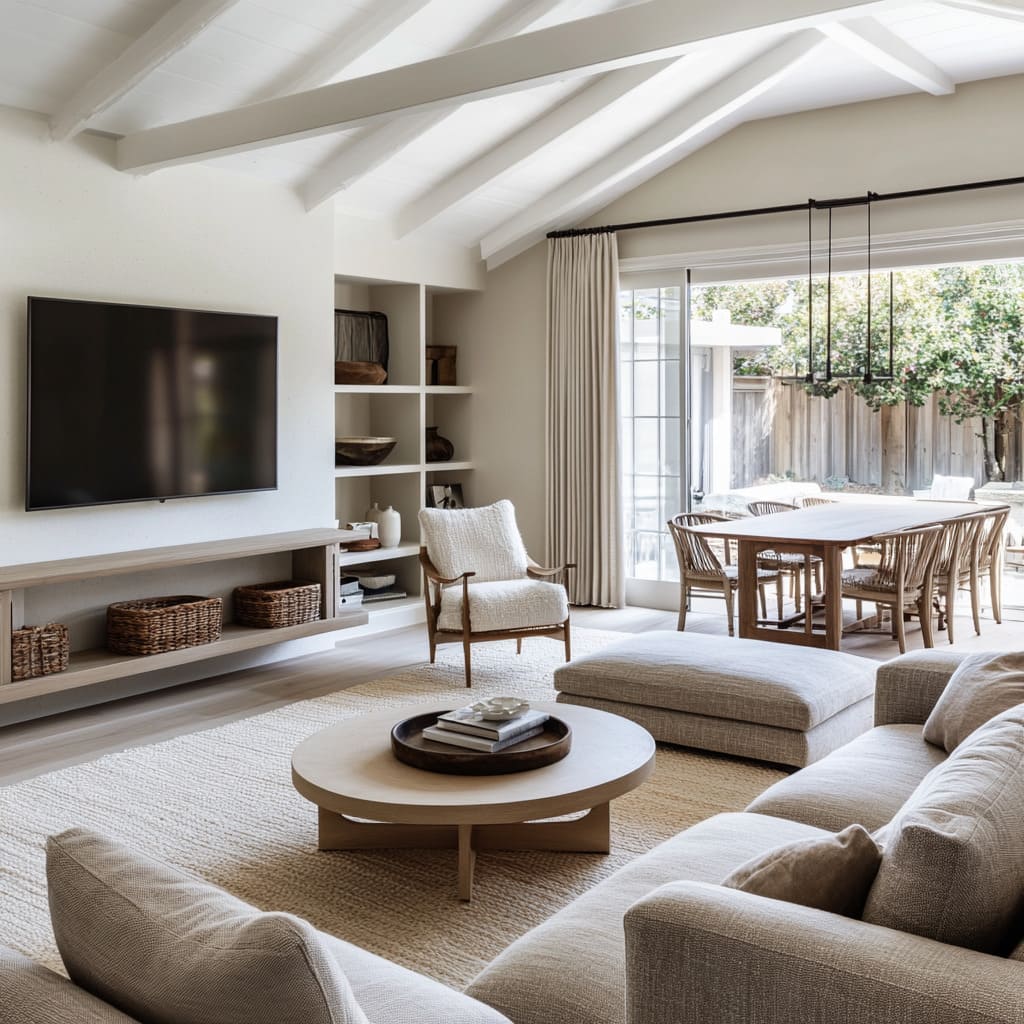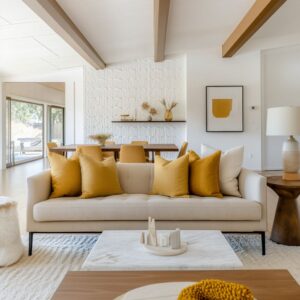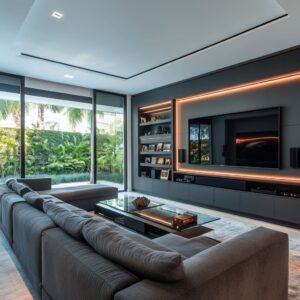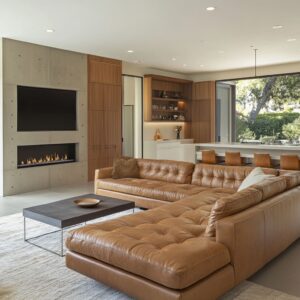Greige living room ideas have gained huge popularity over the last few years, and it’s not hard to see why. This color strikes a fine balance between warm beige and cool gray, making it adaptable, timeless, and incredibly versatile.
But while most articles skim the surface—talking about wall paint or furniture color—this guide goes much deeper. We’re taking a close look at what makes greige living rooms work on an advanced level.
This is a detailed breakdown for homeowners, designers, and anyone who appreciates subtlety. We’ll explore the clever use of tone, texture, and proportion.
We’ll also highlight design choices that aren’t immediately obvious but make all the difference. Whether you love modern simplicity, transitional comfort, or something with a coastal twist, this guide covers it.
And along the way, you’ll pick up ideas that could make your own space look thoughtful and inviting.
The Significance of Subtle Tonal Variations
A Palette That Goes Beyond Basic Greige
A common mistake people make when decorating with greige is treating it as a single, flat color. In fact, the best greige living rooms show a wide range of undertones at play.
Some lean slightly cooler, closer to stone or concrete. Others have a hint of taupe or even mushroom, adding warmth and softness.
This subtle variety creates interest, even in the most neutral spaces. The difference may be subtle to the eye at first, but designers often layer these undertones on purpose.
For example, cooler wall colors can be paired with warmer fabrics to prevent the space from feeling flat. It’s all about balance.
You might spot a creamy greige linen sofa against walls that have a cooler, gray-based tone. This combination makes the room feel layered and dimensional without adding any strong contrast.
Layering Undertones the Smart Way
If you’re working with a greige palette, the trick is to avoid matching everything exactly. While it might seem easier to keep everything the same color, it often results in a space that feels one-dimensional.
Instead, mixing warm and cool greige tones can bring life to the room. One example is a boucle armchair in a soft taupe sitting next to a coffee table finished in pale graywashed oak.
Both pieces are technically greige, but their undertones create a quiet contrast that draws the eye.
Using Texture to Highlight Tone
Another technique is using texture to emphasize tonal variation. Think of a boucle fabric with a soft, nubby finish next to a smooth stone surface.
Even if the color is similar, the way each material reacts to light gives it a different appearance. In many of the most inspiring greige living room ideas, texture plays a huge role in creating this subtle layering effect.
A linen slipcover might look lighter in daylight but slightly darker in the evening, while a matte-finish coffee table stays consistent throughout. The way these materials interact makes a space feel thoughtful, even if the color palette remains quiet and neutral.
Tonal Consistency Makes a Room Feel Larger
Another reason designers love greige is how it can make a room appear larger and more cohesive. Painting walls, trim, and even built-in cabinetry in varying shades of the same greige color creates an unbroken visual flow.
Without sharp color breaks, your eye travels smoothly around the room. This can be especially helpful in smaller spaces or homes with low ceilings.
Subtle shifts in tone—like a slightly darker ceiling beam against a lighter wall—also add structure without making the space feel heavy. In homes where you want architecture to stand out without dominating the decor, this method works especially well.
Sourcing Warmth Through Natural Elements
A modern greige living room often shines brightest when it draws from nature. Even if the color scheme leans cool or muted, organic materials can instantly add a sense of warmth and comfort.
Designers frequently turn to wood, rattan, terracotta, and handwoven fabrics to soften these neutral spaces and make them feel more grounded.
How Light Wood Brings Balance
One of the most effective ways to warm up a greige palette is through the use of light woods, especially oak. In many homes, you’ll find exposed beams or wide plank flooring in a natural finish that adds an understated glow.
These subtle wood tones bring life into the space without shifting the overall palette. Furniture in pale, raw wood finishes can serve a similar role—keeping the room bright but adding depth and character.
Wicker and Cane: Natural Texture That Works
Chairs or accent pieces made from woven materials—like cane, wicker, or rattan—are increasingly popular in warm greige living room designs. The way these pieces filter light and create shadow gives the room a dynamic quality.
Whether it’s a simple cane-back chair or a large pendant light crafted from rattan, these elements lend a relaxed, handcrafted feel that pairs beautifully with a neutral color scheme.
Earth-Toned Accents That Ground the Room
Even small touches can shift the mood. Terracotta vases, pottery in shades of rust, and throw pillows in cocoa or ochre tones bring an earthy richness to greige living rooms.
These items don’t overwhelm the palette but offer contrast where it’s needed. They’re particularly effective in homes that take cues from Mediterranean, desert, or coastal styles.
For example, a trio of ceramic vessels in muted brown on a pale oak shelf can add just enough depth to prevent the space from feeling flat.
Layering Rugs for Texture and Warmth
In homes where farmhouse or coastal influences are strong, you’ll often find a layered approach to rugs. Jute, sisal, and chunky wool weaves create a tactile foundation for the rest of the room.
These natural fibers add an organic softness underfoot and help balance out sleeker materials like stone or metal. Even in minimalist spaces, a large handwoven rug can make a world of difference—bringing warmth without adding visual clutter.
Balancing Structural Lines with Soft Forms
The most striking modern greige living rooms often rely on a simple principle: balance. They combine strong, clean architectural lines with furnishings and décor that offer a softer, more approachable shape.
This contrast prevents the space from feeling cold or sterile and makes it more inviting.
The Power of a Round Coffee Table
Rooms that feature a lot of sharp angles—whether through box beams, squared-off fireplaces, or grid-style window framing—benefit from adding curves. A round or oval coffee table breaks up the straight lines, offering relief for the eye.
In homes where symmetry is key, like many transitional or colonial-inspired designs, a circular table in light wood or stone can soften the room’s structure while still feeling purposeful.
Curved Armchairs for Subtle Comfort
Barrel-back chairs, or those with curved seat contours, have become popular for adding gentle shapes to living areas that might otherwise feel boxy. These pieces often have lower profiles and deep seats, encouraging relaxation without disrupting the clean layout.
In warm greige living rooms, choosing upholstery in soft linen or boucle reinforces this cozy effect, while a neutral palette keeps things cohesive.
Oversized Seating That Invites Relaxation
While many greige spaces celebrate clean lines, there’s also a trend toward using oversized sofas and generously filled cushions. These larger pieces offer balance to angular architecture by adding softness on a larger scale.
Deep sectionals in textured fabrics—like brushed cotton or boucle—help fill out the space, making it feel full without appearing cluttered. Casual pillow arrangements add an extra layer of comfort, especially in homes that aim for a laid-back, family-friendly vibe.
The Fireplace as an Artistic Statement
In today’s greige color living room designs, fireplaces are stepping far beyond their old role as just a source of heat. More and more, they are becoming the centerpieces of the space—quietly commanding attention through texture, material, and clean lines rather than ornamentation.
Playing with Mixed Surfaces
A fireplace wall finished in plaster, lightly marbled for depth, can bring a handcrafted quality that pairs beautifully with the soft hues of a greige palette. Some homes use horizontally laid wood planks with a pale oak stain, adding warmth and structure without the need for extra color.
Others opt for brick painted in pale limestone or washed gray, creating subtle shadow and texture play under different lighting conditions. These choices give the wall its own visual weight, allowing it to stand out while remaining calm and cohesive.
Mantels with a Minimal Role
Mantels in modern spaces are no longer heavy or ornate. They’re often reduced to a slim ledge, sometimes even just a simple plank of wood.
These surfaces double as display areas where less is more. A single round mirror wrapped in rattan or a hand-thrown ceramic vase can be enough to give depth and interest without breaking the room’s flow.
In a space where color is kept subtle, shape and texture step in to do the heavy lifting.
Frameless and Linear Fireboxes
Many modern fireplaces ditch the traditional surround in favor of a clean, frameless opening. A rectangular firebox with sharp edges and a dark metal interior keeps the look simple, shifting focus back to the materials that frame it.
Whether it’s surrounded by pale concrete, lime-washed plaster, or lightly stained wood, this understated approach fits seamlessly into a greige couch living room, keeping everything low-key but high impact.
Emphasis on Architectural Geometry
The structure of a room shapes how it feels, and in many greige living rooms, geometry plays a major role in setting the tone. Strong lines, thoughtful proportions, and symmetry pull everything together, creating spaces that feel balanced and intentional without feeling cold.
Beams That Guide the Eye
Exposed ceiling beams aren’t just for show. In many cases, they are carefully placed to line up with the room’s main features—whether that’s drawing your focus toward the fireplace or reinforcing the layout of the furniture below.
A row of beams running parallel to a greige couch living room arrangement gives a sense of rhythm. These details might not jump out at first glance, but they’re the subtle touches that make a space feel grounded.
The Grid Effect with Windows
Floor-to-ceiling windows divided by slim black mullions create a strong architectural pattern. This grid-like layout works beautifully against the muted colors in a greige color living room.
It adds definition without overwhelming the space. The sharp lines frame outdoor views like artwork and bring a subtle sense of order that balances out softer textures inside.
Shelving That Feels Built-In
Custom built-in shelves often echo the lines of nearby architecture. For example, shelves flanking a fireplace may have vertical planking that mirrors the spacing of ceiling beams or window mullions.
This consistent rhythm helps the shelving blend into the room rather than standing out as separate elements. In many homes, these shelves hold a careful mix of handmade pottery, woven baskets, and a few well-chosen books—all in keeping with the room’s calm, neutral palette.
The Role of Monolithic Furniture Pieces
One of the most understated yet effective ways to bring strength to a greige living room is through substantial, monolithic furniture. These pieces are not about adding color; they’re about adding presence.
In neutral spaces, scale and material often do more work than pattern or bright hues.
Large-Scale Coffee Tables That Ground the Room
A chunky coffee table made from pale oak or honed stone can instantly create a center point. The weight of these tables—both physically and visually—helps to anchor an open-plan layout.
You’ll often see square or rectangular tables with thick slab tops and block-style legs. These designs draw attention without overwhelming the room.
Instead of relying on color to stand out, the focus is on shape, proportion, and material texture. For anyone gathering greige living room decorating ideas, starting with a substantial table can set the tone for the rest of the space.
These pieces work especially well in homes with wide seating arrangements or larger rooms where a lighter table might seem lost. Their size and solid structure make the space feel complete.
Oversized Modular Sofas Create Flow
Another hallmark of modern neutral interiors is the use of generous modular sofas. A wide, bench-seat cushion stretches the eye across the room, removing unnecessary visual breaks.
Designers often choose fabrics in the same tone as the greige living room walls, making the sofa blend seamlessly into its surroundings. This trick shifts the focus to the sofa’s shape—deep seats, broad arms, and soft edges—without introducing contrast that might disrupt the flow.
These oversized sectionals invite relaxation but are also practical for creating structure in large spaces. They help divide open-plan living areas while maintaining an understated look.
Thoughtful Use of Black Accents
Black details are a go-to move for designers working with soft neutral palettes. Without them, greige rooms can sometimes lean too flat or washed out.
Small doses of black add depth and definition, helping to punctuate the space without overwhelming it.
Black Window and Door Frames That Define Boundaries
One of the most noticeable choices in many homes is the use of black-framed windows or doors. Whether it’s slim steel frames or painted wood, these lines provide a crisp contrast against greige living room walls.
This approach gives the eye something to rest on, especially in rooms flooded with natural light. It also works as a subtle link between indoor and outdoor spaces, often found in transitional and contemporary designs.
Black Metal Bases Keep Furniture Light and Grounded
Tables and chairs with slender black metal legs balance out heavier materials like wood or stone. The contrast between black lines and pale flooring makes furniture feel more refined.
It’s a small detail but has a big impact on the room’s sense of balance. For example, a pale wood dining table with black legs can help pull a neutral scheme together by introducing an industrial touch without losing warmth.
Small Decor That Brings Contrast Without Distraction
The easiest way to introduce black is through small accessories—think matte black vases, a simple black-framed mirror, or a sculptural object on a shelf. These pieces add contrast without drawing too much attention.
They work especially well in modern spaces where less really is more. Incorporating black details is one of the most reliable greige living room decorating ideas for anyone looking to add a crisp edge to a soft, neutral setting.
Modern Interpretations of Traditional Roots
Many greige interiors today take their inspiration from historical design but filter it through a modern, simplified lens. It’s a blend of old and new that feels fresh without losing its connection to the past.
The key is restraint—stripping back unnecessary details while respecting the original character.
Colonial Revival, Made Lighter
In traditional Colonial-style homes, heavy wood trim and ornate built-ins were often painted in rich, dark tones. Now, those same features are reimagined in lighter finishes.
Using a single greige tone on both trim and greige wall color living room surfaces creates a sense of openness and calm. The unified color helps the architecture feel more streamlined.
Built-in shelving is kept simple, with minimal styling and neutral decor, bringing a more relaxed atmosphere to what was once a formal space.
Mediterranean Style with a Minimal Touch
Mediterranean influences are another favorite, but today’s take skips the old-world fussiness. Instead of elaborate columns and dark woods, you’ll find smooth plaster walls in sandy greige, often paired with limestone or pale stone accents.
Furniture tends to include slipcovered seating—casual but intentional—and stone block coffee tables that echo the region’s natural materials. Everything feels grounded but light, with plenty of space for air and light to move freely.
Farmhouse Style, Cleaned Up
The modern farmhouse has moved away from rustic overload. Instead of filling a space with shiplap and reclaimed wood, designers are picking one or two key elements—like exposed beams or a simple plaster fireplace—and combining them with clean lines and a monochrome palette.
In these spaces, texture takes the lead, from chunky wool rugs to hand-thrown pottery, but the overall styling stays minimal. Shelves are carefully curated, and the color scheme often stays within a narrow range of soft greys, creams, and warm woods.
Advanced Styling of Shelves and Built-Ins
Shelf styling can be one of the most overlooked details in a living room, but when done thoughtfully, it brings a sense of depth and character that makes the space feel complete. What’s interesting about greige interiors is how they use simplicity to their advantage.
The styling here isn’t busy—it’s purposeful.
Leave Breathing Room
One of the smartest tricks in shelf styling is knowing when to leave space empty. Not every cubby or shelf needs to be filled.
In fact, giving objects room to breathe makes them feel more special. A single ceramic vase or a small stack of books can stand out more when surrounded by negative space.
This approach helps keep built-ins from feeling cluttered, especially in homes with open shelving on either side of a fireplace or media wall.
Grouping Textures That Feel Natural
Neutral rooms often rely on texture rather than color to create interest. Shelves lined with terracotta pots, driftwood, handwoven baskets, or rough ceramics bring in an earthy feel that works perfectly with a muted palette.
Grouping these items in small clusters makes them feel intentional rather than random. A cluster of three items—each with a different height or shape—creates a casual but balanced arrangement.
Horizontal Book Stacks
Books can be styled vertically, but stacking them flat has a different effect. Laying them horizontally in small piles brings a relaxed look, especially when the covers are in shades of cream, sand, or taupe.
Matching the tones of the books to the shelving or surrounding walls helps them blend in while still adding structure. It’s an easy way to introduce lines and form without adding strong color contrast.
Lighting as a Soft Sculptural Element
Lighting in a greige interior isn’t just practical—it shapes the mood and highlights the subtle textures and tones that make these spaces so appealing. Instead of harsh contrasts or bold fixtures, the focus is on gentle forms and diffused glows that enhance the calming atmosphere.
Making the Most of Natural Light
Large windows, sliding doors, and open layouts help flood greige rooms with daylight. It’s common to see sheer or lightweight linen curtains used to soften that light.
The fabric’s relaxed drape adds movement and texture, balancing out the structured lines often found in ceiling beams or built-in cabinetry. These treatments allow sunlight to filter in while maintaining privacy, creating a quiet, comfortable vibe throughout the day.
Layered Artificial Lighting That Complements the Palette
When the sun sets, well-chosen light fixtures step in. Recessed lighting often provides the foundation, but it’s the carefully placed sconces, floor lamps, and pendants that add depth.
Paper Lantern PendantsThese round fixtures are a favorite for adding softness overhead. The light they cast is diffused, perfect for warming up a space that leans neutral or minimal.
The organic shape of a paper lantern can balance out the sharper lines of a modern space, bringing an unexpected, yet subtle, contrast.
Muted Metal Finishes
In a room filled with pale walls and soft furniture, the last thing you want is overly shiny hardware. That’s why matte finishes—like black iron or antique brass—are often used for sconces and table lamps.
They blend into the color scheme but still offer contrast in texture. These choices work well in greige lounge ideas where the goal is a cohesive look with a few standout elements.
New Directions and Emerging Nuances
Greige interiors have always been known for their subtlety, but newer trends are pushing that concept into fresh territory. Designers are rethinking materials and forms to add depth and character, without losing the calm and understated tone people love about greige spaces.
Unpolished Plaster and Microcement Finishes
Plaster and microcement are showing up more often, especially on fireplace walls and accent panels. They bring a raw, hand-applied look that’s far from cold.
The texture adds interest without introducing busy patterns. It’s a move that fits well in minimal settings but adds a bit of artistry at the same time.
Monochrome Stone That Blends with Walls
Instead of high-contrast stone surfaces, some designers are now choosing materials that nearly match the wall color. A fireplace clad in pale limestone, close in tone to greige walls, creates a seamless flow.
The focus shifts to the stone’s texture and veining, offering subtle variation while keeping the look clean.
Sculptural Greenery, Less About Foliage
Houseplants remain popular, but their role is changing. Instead of tropical palms or oversized fiddle-leaf figs, the trend leans toward simpler, more architectural greenery.
Olive trees, bare branches, or dried grasses in a tall vase provide form and height without overwhelming the palette. It’s a thoughtful way to bring nature inside while maintaining the room’s balance.
Blending Different Styles Seamlessly
One of the more interesting directions in current greige interiors is the quiet mix of influences. A colonial-style mantel might sit comfortably alongside a mid-century lounge chair or a Mediterranean-inspired stone table.
The common thread is a consistent, neutral palette. This approach makes it easy to blend different eras and regions in a way that feels natural and intentional.
Practical Considerations: Durability and Maintenance
One of the biggest advantages of a greige palette is how easy it is to live with, especially in busy homes. While the color feels soft and subtle, it can handle real life—kids, pets, and everything in between—without losing its appeal.
The key is making smart material choices that hold up over time while maintaining the effortless look that greige interiors are known for.
Performance Fabrics That Take the Stress Out of Spills
Fabrics like performance linen or Crypton blends are popular because they combine style with practicality. They offer the same relaxed texture and neutral tone people love in a greige living space but are treated to resist stains and moisture.
This makes them ideal for family rooms or homes where the sofa doubles as a hangout zone. You get the comfort of a casual look without having to constantly worry about accidents.
Flooring That Stays Comfortable and Clean
Flatweave wool rugs and indoor-outdoor blends are another smart move. They’re durable enough to handle heavy foot traffic but soft enough to make the space inviting.
These materials are easier to clean than high-pile rugs, which is a big plus in high-use areas. Choosing a rug that complements a greige color scheme helps tie everything together while adding another layer of texture.
Hidden Storage That Keeps Clutter Out of Sight
Integrated storage solutions—like built-in cabinetry painted to match the greige living room walls—help keep things looking tidy. Closed cabinets make it easy to stow away books, toys, and everyday mess without breaking the room’s visual flow.
Everything has a place, but nothing distracts from the overall feel of the room.
Closing Thoughts on Depth, Texture, and Balance
Greige often gets labeled as a safe color choice, but the truth is, when used thoughtfully, it brings a level of depth and sophistication that few other palettes can match. A well-executed greige living room strikes a balance between calm and interest.
It’s a space that draws you in without shouting for attention. By layering different textures—whether it’s a chunky wool rug, a smooth plaster fireplace, or a matte black metal lamp—you add richness to the space.
Variations in undertones, from cooler greys to warmer taupes, give dimension without adding strong color contrast. And the layout matters too: aligning ceiling beams with window mullions, or placing furniture to mirror architectural lines, creates harmony that makes the room feel complete.
If you take inspiration from these ideas—whether it’s a large, blocky coffee table that grounds the seating area or a pair of black-framed windows that break up an otherwise neutral palette—you’ll find that a greige space becomes anything but boring. The key is in the details.
Subtle shifts, thoughtful choices, and attention to proportion turn a quiet room into one with a strong, lasting impression.
